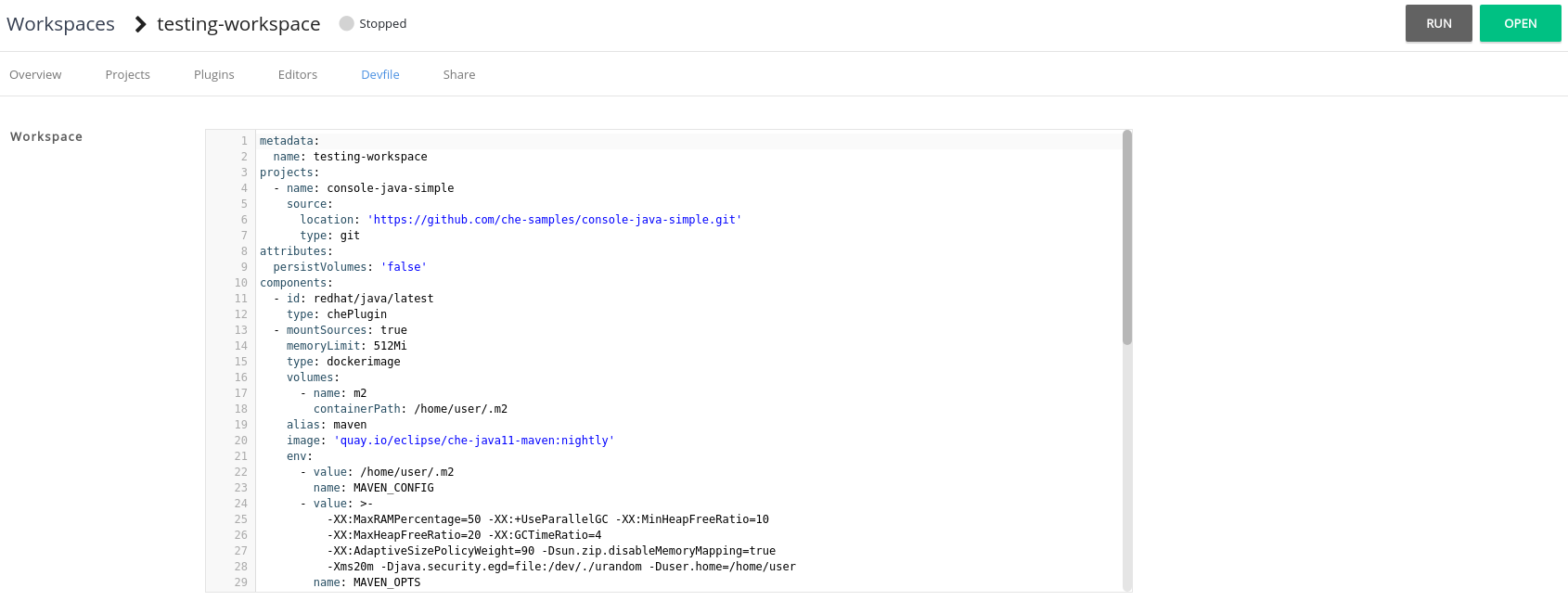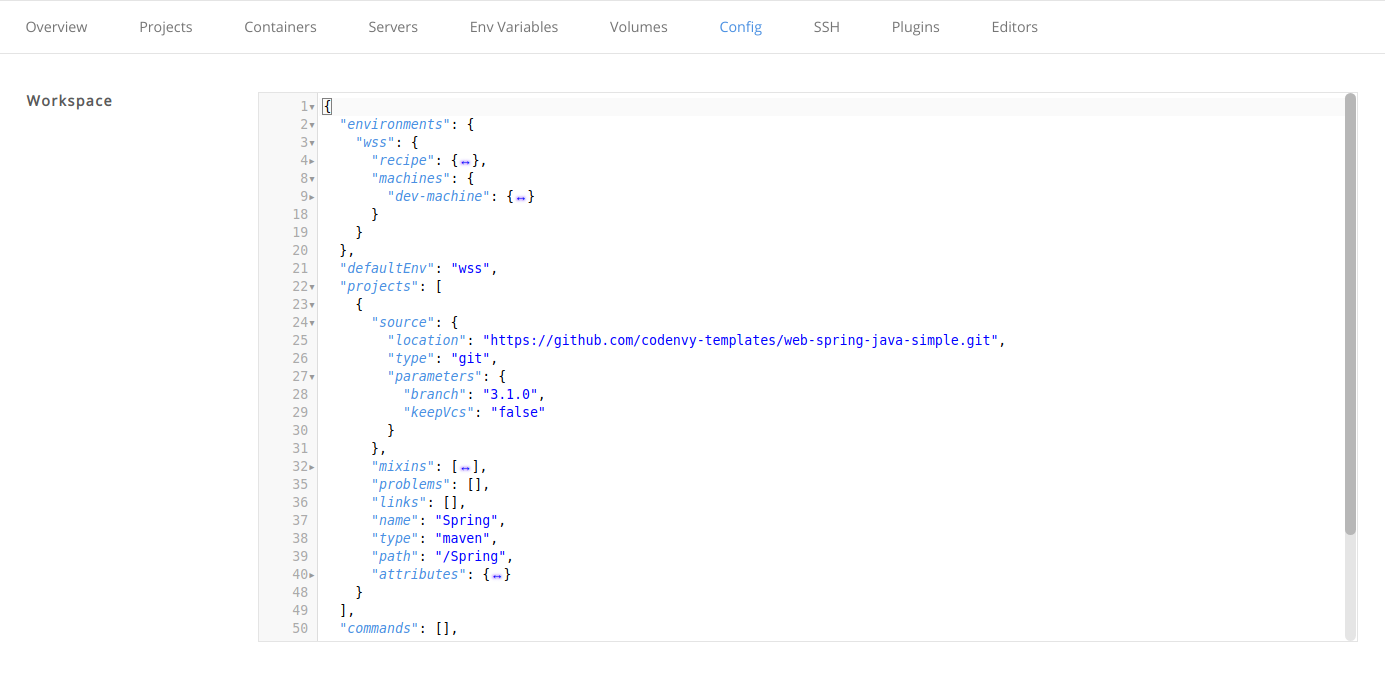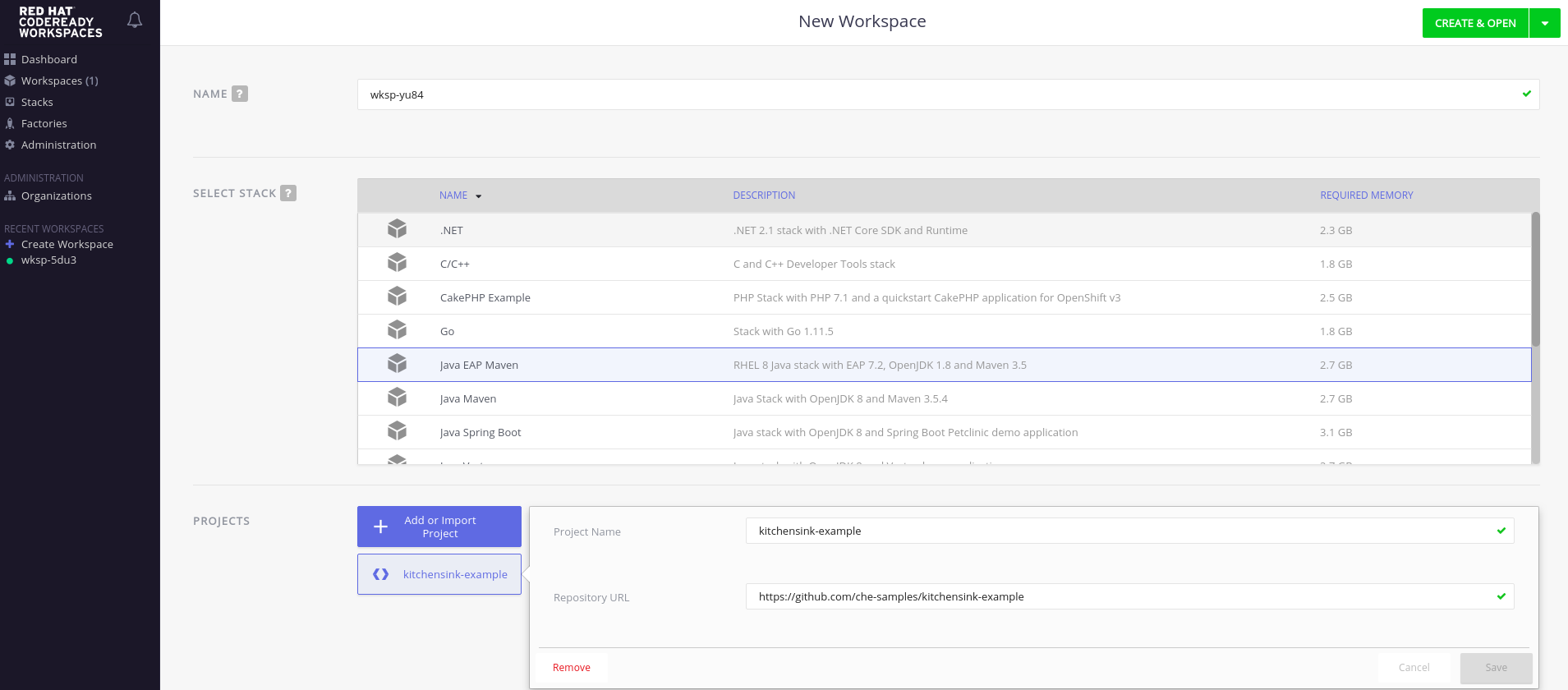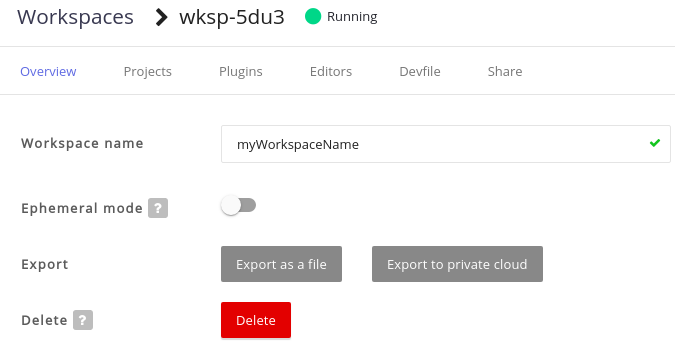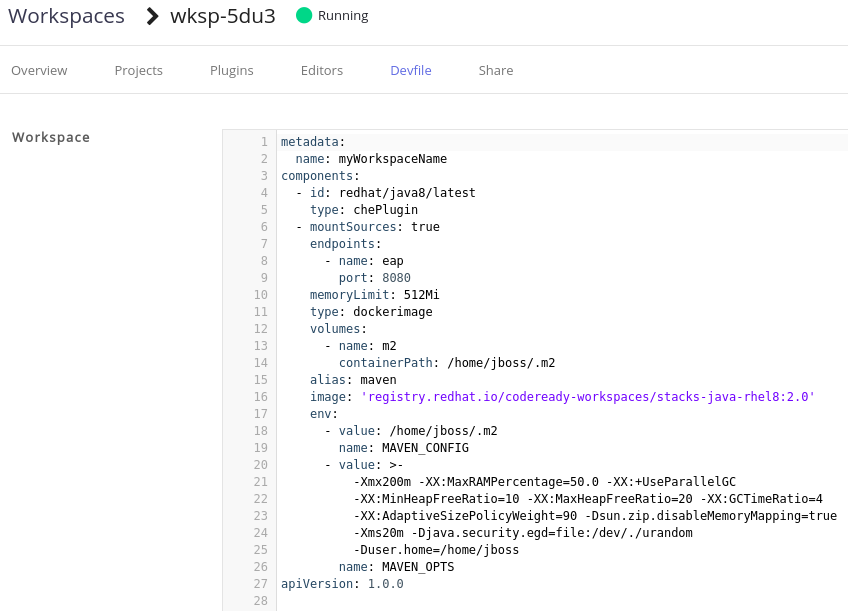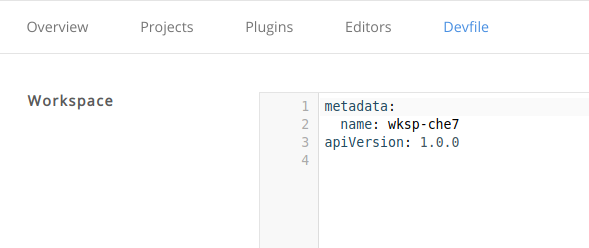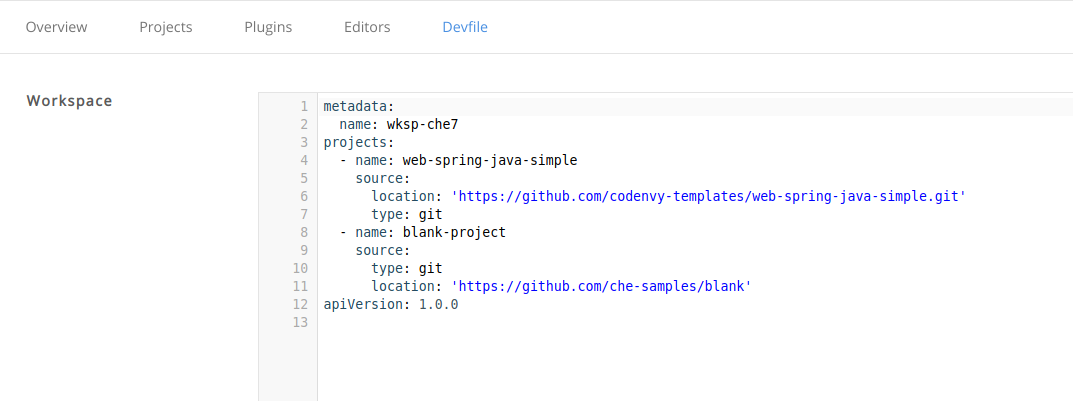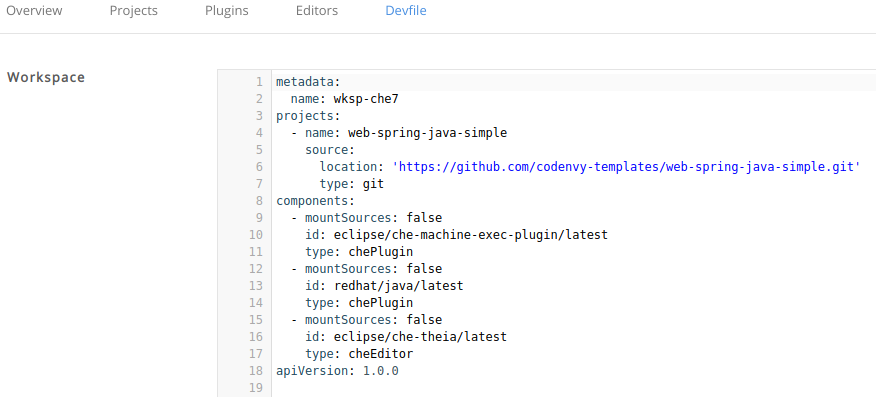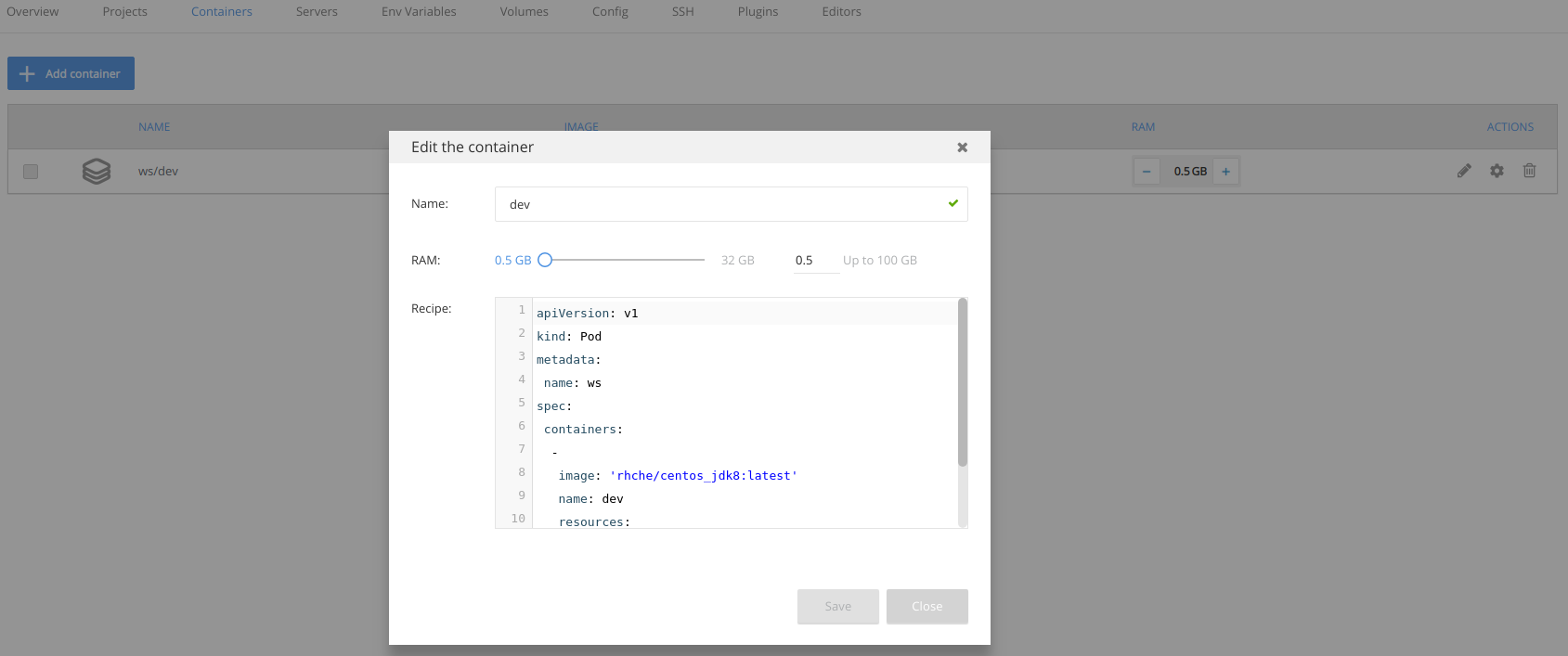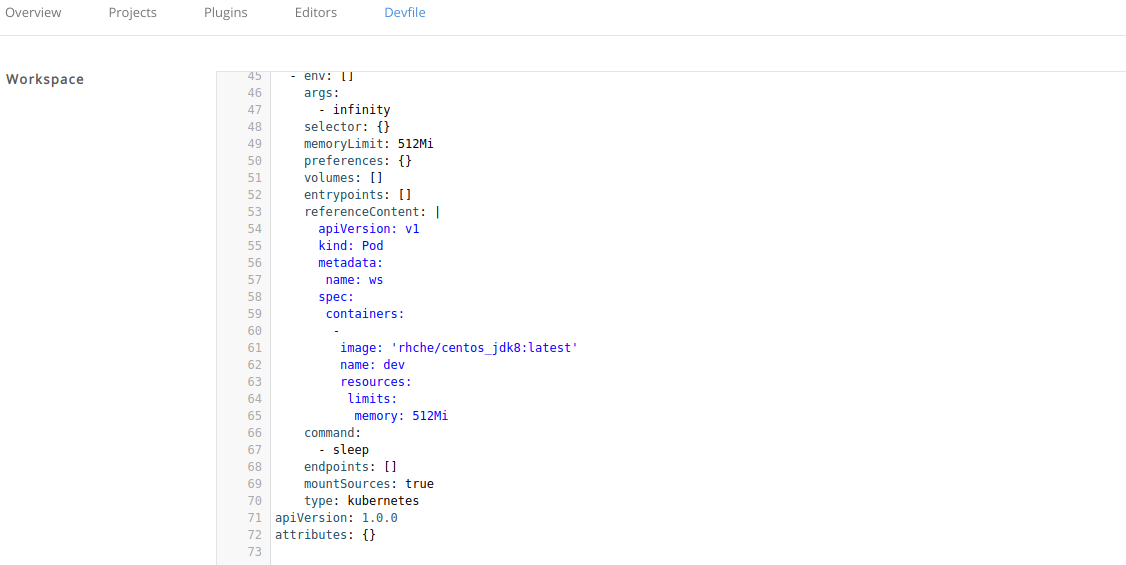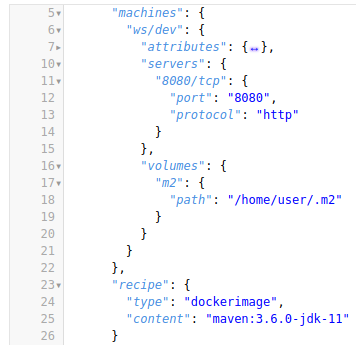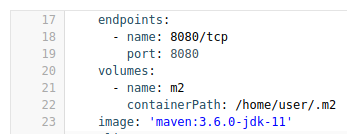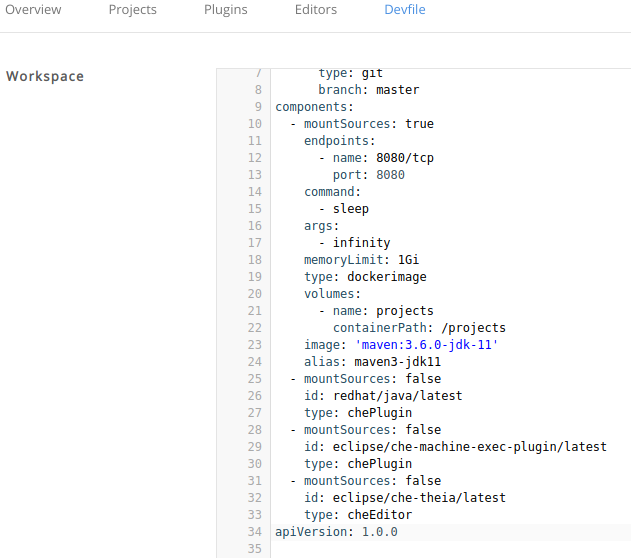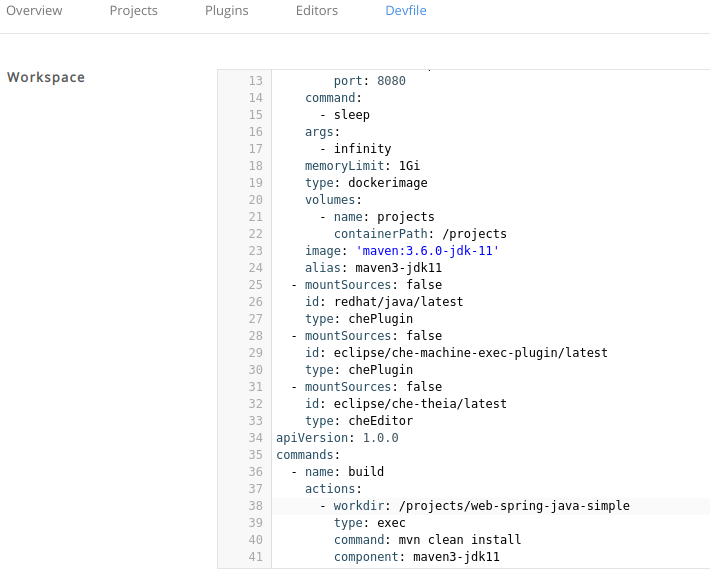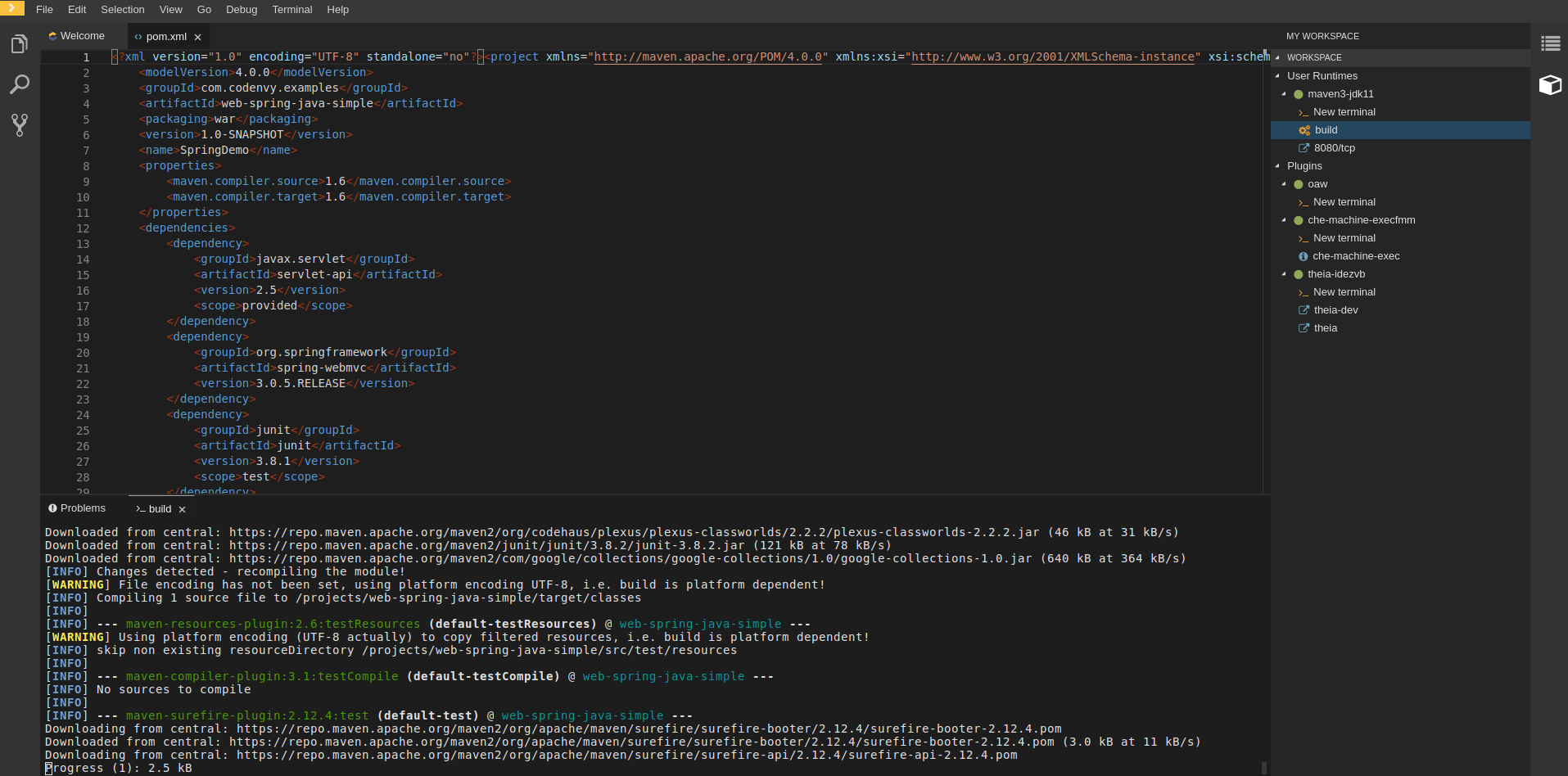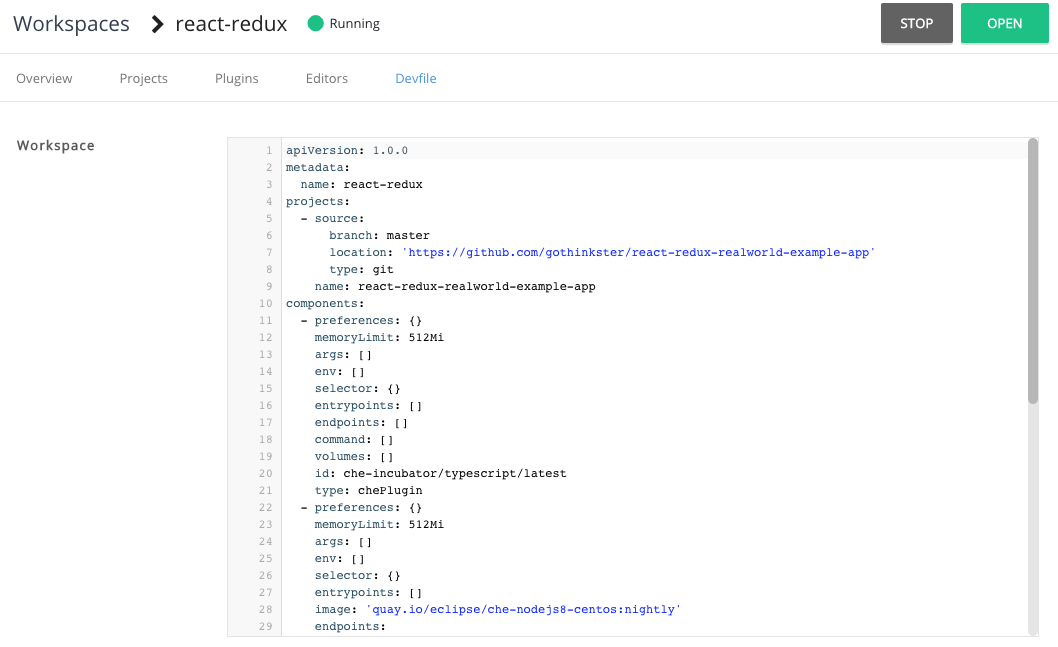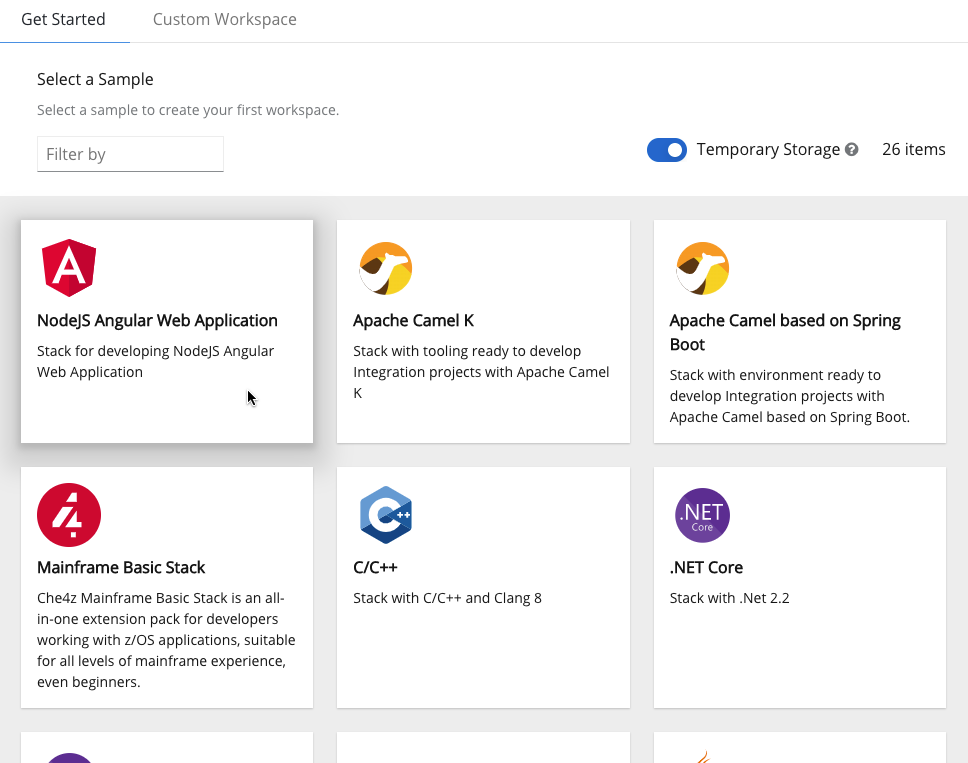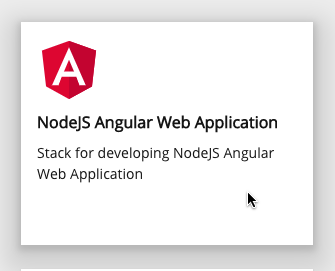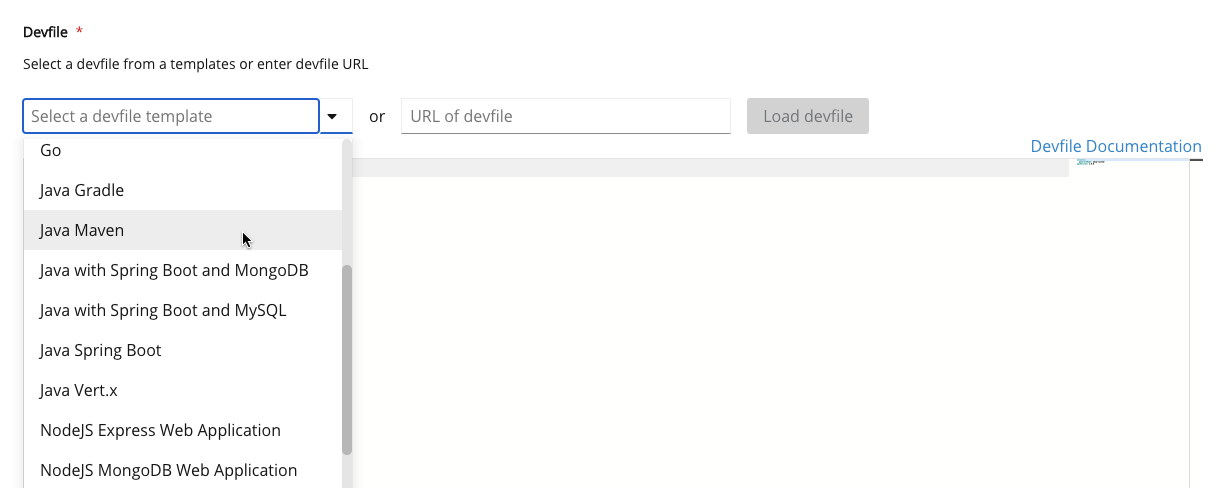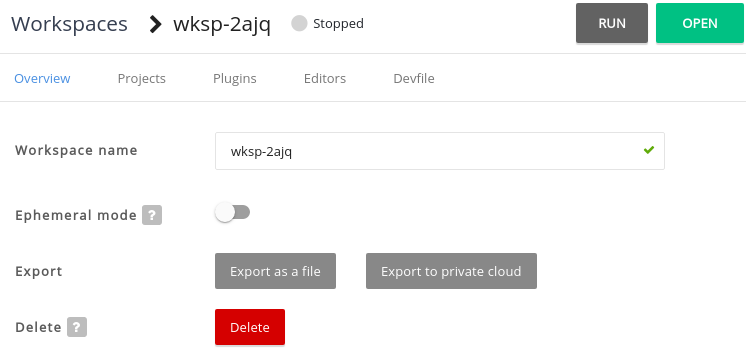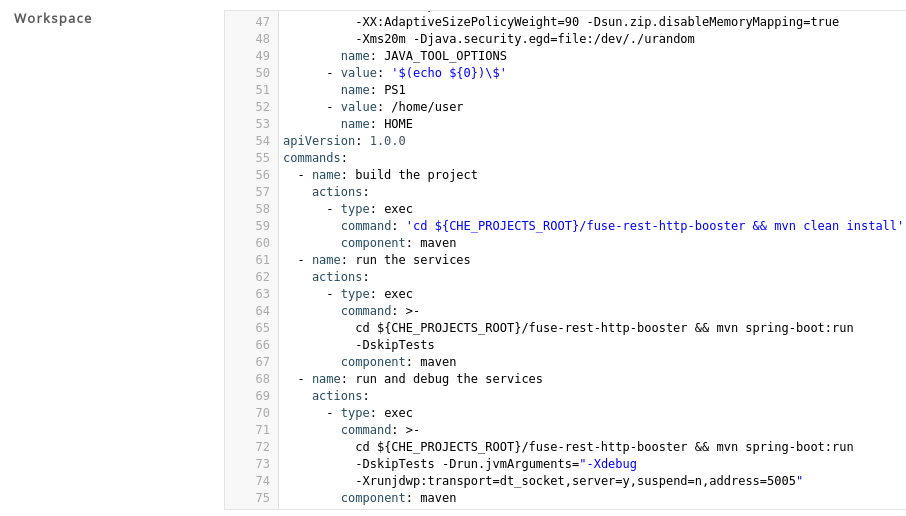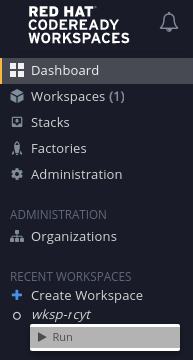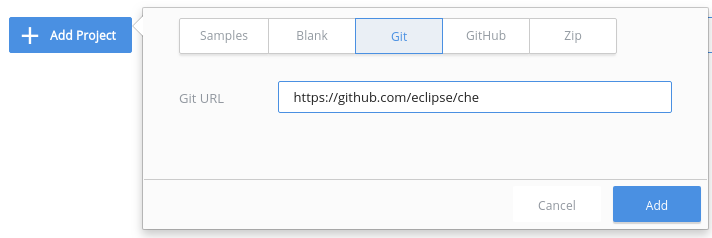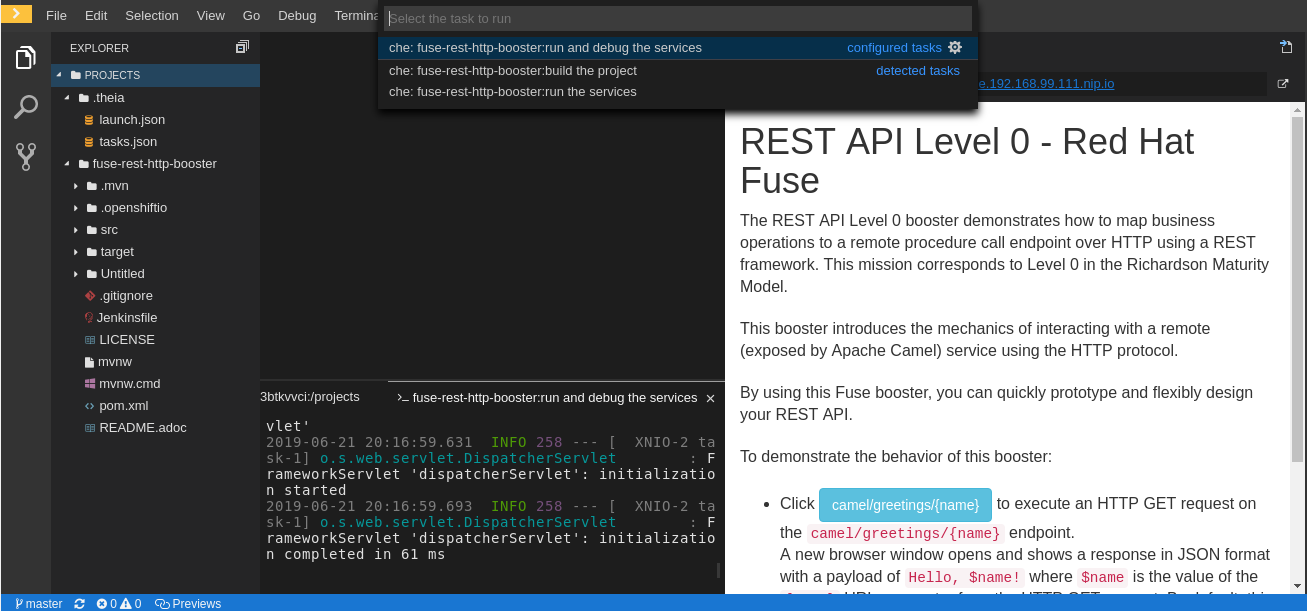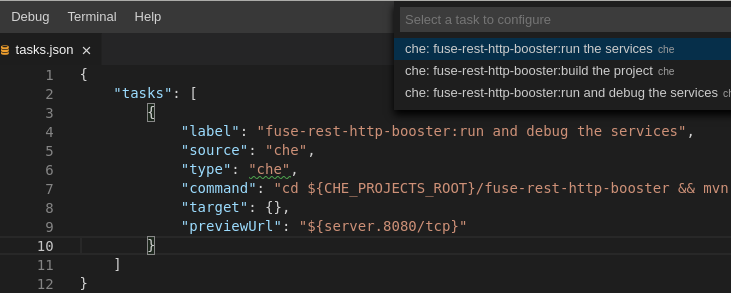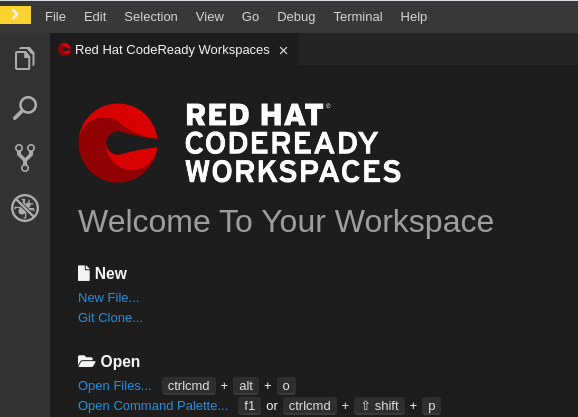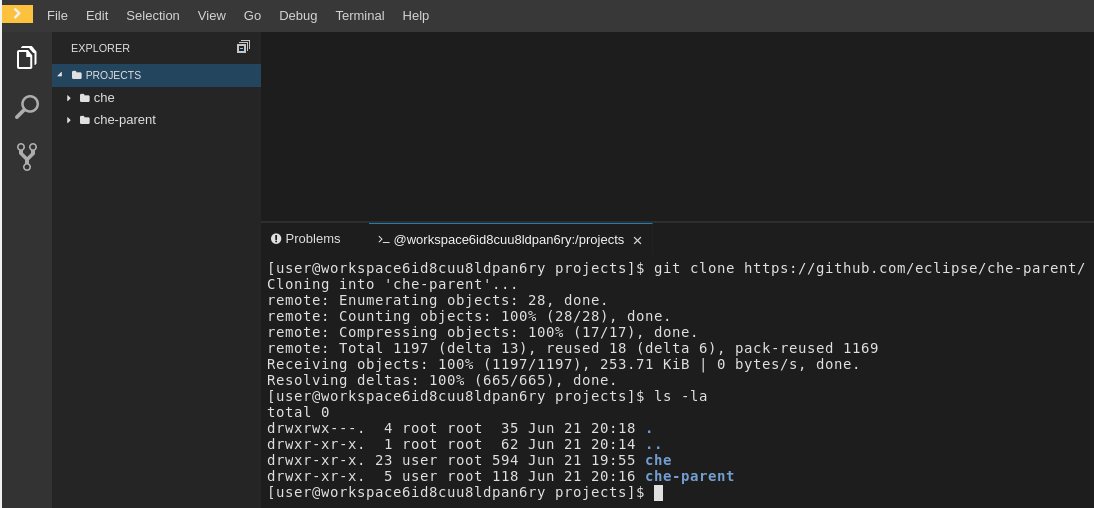Chapter 3. Workspaces overview
Red Hat CodeReady Workspaces provides developer workspaces with everything needed to a code, build, test, run, and debug applications. To allow that, the developer workspaces provide four main components:
- The source code of a project.
- A web-based IDE.
- Tool dependencies, needed by developers to work on a project
- Application runtime: a replica of the environment where the application runs in production
Pods manage each component of a CodeReady Workspaces workspace. Therefore, everything running in a CodeReady Workspaces workspace is running inside containers. This makes a CodeReady Workspaces workspace highly portable.
The embedded browser-based IDE is the point of access for everything running in a CodeReady Workspaces workspace. This makes a CodeReady Workspaces workspace easily shareable.
By default, it is possible to run only one workspace at a time. To change the default value, see: {link-limits-for-user-workspaces}.
| Features | Traditional IDE workspaces | Red Hat CodeReady Workspaces workspaces |
|---|---|---|
| Configuration and installation required | Yes. | No. |
| Embedded tools | Partial. IDE plug-ins need configuration. Dependencies need installation and configuration. Example: JDK, Maven, Node. | Yes. Plug-ins provide their dependencies. |
| Application runtime provided | No. Developers have to manage that separately. | Yes. Application runtime is replicated in the workspace. |
| Shareable | No. Or not easily | Yes. Developer workspaces are shareable with a URL. |
| Versionable | No | Yes. Devfiles exist with project source code. |
| Accessible from anywhere | No. Installation is needed. | Yes. Only requires a browser. |
To start a CodeReady Workspaces workspace, following options are available:
Use the Dashboard to discover CodeReady Workspaces 2.1:
Use a devfile as the preferred way to start a CodeReady Workspaces 2.1 workspace:
Use the browser-based IDE as the preferred way to interact with a CodeReady Workspaces 2.1 workspace. For an alternative way to interact with a CodeReady Workspaces 2.1 workspace, see: Remotely accessing workspaces.
3.1. Configuring a workspace using a devfile
To quickly and easily configure a CodeReady Workspaces workspace, use a devfile. For an introduction to devfiles and instructions for their use, see the instructions in this section.
3.1.1. What is a devfile
A devfile is a file that describes and define a development environment:
- the source code
- the development components (browser IDE tools and application runtimes)
- a list of pre-defined commands
- projects to clone
Devfiles are YAML files that CodeReady Workspaces consumes and transforms into a cloud workspace composed of multiple containers. The devfile can be saved in the root folder of a Git repository, a feature branch of a Git repository, a publicly accessible destination, or as a separate, locally stored artifact.
When creating a workspace, CodeReady Workspaces uses that definition to initiate everything and run all the containers for the required tools and application runtimes. CodeReady Workspaces also mounts file-system volumes to make source code available to the workspace.
Devfiles can be versioned with the project source code. When there is a need for a workspace to fix an old maintenance branch, the project devfile provides a definition of the workspace with the tools and the exact dependencies to start working on the old branch. Use it to instantiate workspaces on demand.
CodeReady Workspaces maintains the devfile up-to-date with the tools used in the workspace:
- Projects of the workspace (path, Git location, branch)
- Commands to perform daily tasks (build, run, test, debug)
- Runtime environment (container images to run the application)
- Che-Theia plug-ins with tools, IDE features, and helpers that a developer would use in the workspace (Git, Java support, SonarLint, Pull Request)
3.1.2. Disambiguation between stacks and devfiles
This section describes differences between stacks in CodeReady Workspaces 2.0 and devfiles in CodeReady Workspaces 2.1
Starting with CodeReady Workspaces 2.1:
- A stack is a pre-configured CodeReady Workspaces workspace.
- A devfile is a configuration YAML file that CodeReady Workspaces consumes and transforms in a cloud workspace composed of multiple containers.
In CodeReady Workspaces 2.0, stacks were defined by a stacks.json file that was included with the che server. In contrast, in CodeReady Workspaces 2.1, the stacks.json file does not exist. Instead, a stack is defined in the devfile registry, which is a separate service. Every single devfile in the registry corresponds to a stack.
Note that in CodeReady Workspaces 2.0, stacks and workspaces were defined using two different formats. However, with CodeReady Workspaces 2.1, the devfile format is used to define both the stacks and the workspaces. Nevertheless, a user opening the user dashboard does not notice any difference: in CodeReady Workspaces 2.1, a list of stacks is still present to choose from as a starting point to create a workspace.
3.1.3. Creating a workspace from the default branch of a Git repository
A CodeReady Workspaces workspace can be created by pointing to a devfile that is stored in a Git source repository. The CodeReady Workspaces instance then uses the discovered devfile.yaml file to build a workspace using the /f?url= API.
Prerequisites
- A running instance of Red Hat CodeReady Workspaces. To install an instance of Red Hat CodeReady Workspaces, see the CodeReady Workspaces 2.1 Installation GuideCodeReady Workspaces quick-starts.
-
The
devfile.yamlfile in the root folder of a Git repository available over HTTPS. See Making a workspace portable using a devfile for detailed information about creating and using devfiles.
Procedure
Run the workspace by opening the following URL: https://codeready-<openshift_deployment_name>.<domain_name>/f?url=https://<GitRepository>
Example
https://che.openshift.io/f?url=https://github.com/eclipse/che
https://che.openshift.io/f?url=https://github.com/eclipse/che3.1.4. Creating a workspace from a feature branch of a Git repository
A CodeReady Workspaces workspace can be created by pointing to devfile that is stored in a Git source repository on a feature branch of the user’s choice. The CodeReady Workspaces instance then uses the discovered devfile to build a workspace.
Prerequisites
- A running instance of Red Hat CodeReady Workspaces. To install an instance of Red Hat CodeReady Workspaces, see the CodeReady Workspaces 2.1 Installation GuideCodeReady Workspaces quick-starts.
-
The
devfile.yamlfile in the root folder of a Git repository on a specific branch of the user’s choice available over HTTPS. See Making a workspace portable using a devfile for detailed information about creating and using devfiles.
Procedure
Execute the workspace by opening the following URL: https://codeready-<openshift_deployment_name>.<domain_name>/f?url=<GitHubBranch>
Example
Use following URL format to open an experimental quarkus-quickstarts branch hosted on che.openshift.io.
https://che.openshift.io/f?url=https://github.com/maxandersen/quarkus-quickstarts/tree/che
https://che.openshift.io/f?url=https://github.com/maxandersen/quarkus-quickstarts/tree/che3.1.5. Creating a workspace from a publicly accessible standalone devfile using HTTP
A workspace can be created using a devfile, the URL of which is pointing to the raw content of the devfile. The CodeReady Workspaces instance then uses the discovered devfile to build a workspace.
Prerequisites
- A running instance of Red Hat CodeReady Workspaces. To install an instance of Red Hat CodeReady Workspaces, see the CodeReady Workspaces 2.1 Installation GuideCodeReady Workspaces quick-starts.
-
The publicly-accessible standalone
devfile.yamlfile. See Making a workspace portable using a Devfile for detailed information about creating and using devfiles.
Procedure
-
Execute the workspace by opening the following URL:
{prod-fun}/f?url=https://<yourhosturl>/devfile.yaml
Example
https://che.openshift.io/f?url=https://gist.githubusercontent.com/themr0c/ef8e59a162748a8be07e900b6401e6a8/raw/8802c20743cde712bbc822521463359a60d1f7a9/devfile.yaml
https://che.openshift.io/f?url=https://gist.githubusercontent.com/themr0c/ef8e59a162748a8be07e900b6401e6a8/raw/8802c20743cde712bbc822521463359a60d1f7a9/devfile.yaml3.1.6. Overriding devfile values using factory parameters
Values in the following sections of a remote devfile can be overridden using specially constructed additional factory parameters:
-
apiVersion -
metadata -
projects -
attributes
Prerequisites
- A running instance of Red Hat CodeReady Workspaces. To install an instance of Red Hat CodeReady Workspaces, see the CodeReady Workspaces 2.1 Installation GuideCodeReady Workspaces quick-starts.
-
A publicly accessible standalone
devfile.yamlfile. See Making a workspace portable using a Devfile for detailed information about creating and using devfiles.
Procedure
-
Open the workspace by navigating to the following URL:
https://codeready-<openshift_deployment_name>.<domain_name>/f?url=https://<hostURL>/devfile.yaml&override.<parameter.path>=<value>
Example of overriding the generateName property
Consider the following initial devfile:
To add or override generateName value, the following factory URL can be used:
https://che.openshift.io/f?url=https://gist.githubusercontent.com/themr0c/ef8e59a162748a8be07e900b6401e6a8/raw/8802c20743cde712bbc822521463359a60d1f7a9/devfile.yaml&override.metadata.generateName=myprefix
https://che.openshift.io/f?url=https://gist.githubusercontent.com/themr0c/ef8e59a162748a8be07e900b6401e6a8/raw/8802c20743cde712bbc822521463359a60d1f7a9/devfile.yaml&override.metadata.generateName=myprefixThe resulting workspace will have the following devfile model:
Example of overriding project source branch property
Consider the following initial devfile:
To add or override source branch value, the following factory URL can be used:
https://che.openshift.io/f?url=https://gist.githubusercontent.com/themr0c/ef8e59a162748a8be07e900b6401e6a8/raw/8802c20743cde712bbc822521463359a60d1f7a9/devfile.yaml&override.projects.web-java-spring-petclinic.source.branch=1.0.x
https://che.openshift.io/f?url=https://gist.githubusercontent.com/themr0c/ef8e59a162748a8be07e900b6401e6a8/raw/8802c20743cde712bbc822521463359a60d1f7a9/devfile.yaml&override.projects.web-java-spring-petclinic.source.branch=1.0.xThe resulting workspace will have the following devfile model:
Example of overriding or creating an attribute value
Consider the following initial devfile:
To add or override persistVolumes attribute value, the following factory URL can be used:
https://che.openshift.io/f?url=https://gist.githubusercontent.com/themr0c/ef8e59a162748a8be07e900b6401e6a8/raw/8802c20743cde712bbc822521463359a60d1f7a9/devfile.yaml&override.attributes.persistVolumes=true
https://che.openshift.io/f?url=https://gist.githubusercontent.com/themr0c/ef8e59a162748a8be07e900b6401e6a8/raw/8802c20743cde712bbc822521463359a60d1f7a9/devfile.yaml&override.attributes.persistVolumes=trueThe resulting workspace will have the following devfile model:
When overriding attributes, everything that follows the attributes keyword treat as an attribute name, so it’s possible to use dot-separated names:
https://che.openshift.io/f?url=https://gist.githubusercontent.com/themr0c/ef8e59a162748a8be07e900b6401e6a8/raw/8802c20743cde712bbc822521463359a60d1f7a9/devfile.yaml&override.attributes.dot.name.format.attribute=true
https://che.openshift.io/f?url=https://gist.githubusercontent.com/themr0c/ef8e59a162748a8be07e900b6401e6a8/raw/8802c20743cde712bbc822521463359a60d1f7a9/devfile.yaml&override.attributes.dot.name.format.attribute=trueThe resulting workspace will have the following devfile model:
3.1.7. Creating a workspace using crwctl and a local devfile
A CodeReady Workspaces workspace can be created by pointing the crwctl tool to a locally stored devfile. The CodeReady Workspaces instance then uses the discovered devfile to build a workspace.
Prerequisites
- A running instance of Red Hat CodeReady Workspaces. To install an instance of Red Hat CodeReady Workspaces, see the CodeReady Workspaces 2.1 Installation GuideCodeReady Workspaces quick-starts.
-
The CodeReady Workspaces CLI management tool. See the CodeReady Workspaces 2.1 Installation GuideInstalling the
crwctlmanagement tool. The devfile is available on the local filesystem in the current working directory. See Making a workspace portable using a Devfile for detailed information about creating and using devfiles.
Example
Download the
devfile.yamlfile from the GitHub repository to the current working directory.
Procedure
-
Run a workspace from a devfile using the
workspace:startparameter with thecrwctltool as follows:
crwctl workspace:start --devfile=devfile.yaml
$ crwctl workspace:start --devfile=devfile.yamlAdditional resources
3.2. Making a workspace portable using a devfile
To transfer a configured CodeReady Workspaces workspace, create and export the devfile of the workspace and load the devfile on a different host to initialize a new instance of the workspace. For detailed instructions on how to create such a devfile, see below.
3.2.1. What is a devfile
A devfile is a file that describes and define a development environment:
- the source code
- the development components (browser IDE tools and application runtimes)
- a list of pre-defined commands
- projects to clone
Devfiles are YAML files that CodeReady Workspaces consumes and transforms into a cloud workspace composed of multiple containers. The devfile can be saved in the root folder of a Git repository, a feature branch of a Git repository, a publicly accessible destination, or as a separate, locally stored artifact.
When creating a workspace, CodeReady Workspaces uses that definition to initiate everything and run all the containers for the required tools and application runtimes. CodeReady Workspaces also mounts file-system volumes to make source code available to the workspace.
Devfiles can be versioned with the project source code. When there is a need for a workspace to fix an old maintenance branch, the project devfile provides a definition of the workspace with the tools and the exact dependencies to start working on the old branch. Use it to instantiate workspaces on demand.
CodeReady Workspaces maintains the devfile up-to-date with the tools used in the workspace:
- Projects of the workspace (path, Git location, branch)
- Commands to perform daily tasks (build, run, test, debug)
- Runtime environment (container images to run the application)
- Che-Theia plug-ins with tools, IDE features, and helpers that a developer would use in the workspace (Git, Java support, SonarLint, Pull Request)
3.2.2. A minimal devfile
The following is the minimum content required in a devfile.yaml file:
apiVersion: 1.0.0 metadata: name: che-in-che-out
apiVersion: 1.0.0
metadata:
name: che-in-che-outFor a complete devfile example, see Red Hat CodeReady Workspaces in CodeReady Workspaces devfile.yaml.
name or generateName must be defined
Both name and generateName are optional parameters, but at least one of them must be defined. See Section 3.2.3, “Generating workspace names”.
3.2.3. Generating workspace names
To specify a prefix for automatically generated workspace names, set the generateName parameter in the devfile.yaml file:
apiVersion: 1.0.0 metadata: generateName: che-
apiVersion: 1.0.0
metadata:
generateName: che-
The workspace name will be in the <generateName>YYYYY format (for example, che-2y7kp). Y is random [a-z0-9] character.
The following naming rules apply when creating workspaces:
-
When
nameis defined, it is used as the workspace name:<name> -
When only
generateNameis defined, it is used as the base of the generated name:<generateName>YYYYY
For workspaces created using a factory, defining name or generateName has the same effect. The defined value is used as the name prefix: <name>YYYYY or <generateName>YYYYY. When both generateName and name are defined, generateName takes precedence.
3.2.4. Writing a devfile for a project
This section describes how to create a minimal devfile for your project and how to include more than one projects in a devfile.
3.2.4.1. Preparing a minimal devfile
A minimal devfile sufficient to run a workspace consists of the following parts:
- Specification version
- Name
Example of a minimal devfile with no project
apiVersion: 1.0.0 metadata: name: minimal-workspace
apiVersion: 1.0.0
metadata:
name: minimal-workspaceWithout any further configuration, a workspace with the default editor is launched along with its default plug-ins, which are configured on the CodeReady Workspaces Server. Che-Theia is configured as the default editor along with the CodeReady Workspaces Machine Exec plug-in. When launching a workspace within a Git repository using a factory, the project from the given repository and branch is be created by default. The project name then matches the repository name.
Add the following parts for a more functional workspace:
- List of components: Development components and user runtimes
- List of projects: Source code repositories
- List of commands: Actions to manage the workspace components, such as running the development tools, starting the runtime environments, and others
Example of a minimal devfile with a project
3.2.4.2. Specifying multiple projects in a devfile
A single devfile can specify multiple projects. For each project, specify the type of the source repository, its location, and, optionally, the directory the project is cloned to.
Example of a devfile with two projects
In the preceding example, there are two projects defined, frontend and backend. Each project is located in its own repository. The backend project has a specific requirement to be cloned into the src/github.com/acmecorp/backend/ directory under the source root (implicitly defined by the CodeReady Workspaces runtime) while the frontend project will be cloned into the frontend/ directory under the source root.
Additional resources
For a detailed explanation of all devfile component assignments and possible values, see:
These sample devfiles are a good source of inspiration:
3.2.5. Devfile reference
This section contains devfile reference and instructions on how to use the various elements that devfiles consist of.
3.2.5.1. Adding projects to a devfile
Usually a devfile contains one or more projects. A workspace is created to develop those projects. Projects are added in the projects section of devfiles.
Each project in a single devfile must have:
- Unique name
- Source specified
Project source consists of two mandatory values: type and location.
type- The kind of project-source provider.
location- The URL of project source.
CodeReady Workspaces supports the following project types:
git- Projects with sources in Git. The location points to a clone link.
github-
Same as
gitbut for projects hosted on GitHub only. Usegitfor projects that do not use GitHub-specific features. zip- Projects with sources in a ZIP archive. Location points to a ZIP file.
3.2.5.1.1. Project-source type: git
- 1
startPointis the general value fortag,commitId, andbranch. ThestartPoint,tag,commitId, andbranchparameters are mutually exclusive. When more than one is supplied, the following order is used:startPoint,tag,commitId,branch.- 2
sparseCheckoutDirthe template for the sparse checkout Git feature. This is useful when only a part of a project (typically only a single directory) is needed.
Example 3.1. sparseCheckoutDir parameter settings
-
Set to
/my-module/to create only the rootmy-moduledirectory (and its content). Omit the leading slash (
my-module/) to create allmy-moduledirectories that exist in the project. Including, for example,/addons/my-module/.The trailing slash indicates that only directories with the given name (including their content) are created.
-
Use wildcards to specify more than one directory name. For example, setting
module-*checks out all directories of the given project that start withmodule-.
For more information, see Sparse checkout in Git documentation.
3.2.5.1.2. Project-source type: zip
source:
type: zip
location: http://host.net/path/project-src.zip
source:
type: zip
location: http://host.net/path/project-src.zip3.2.5.1.3. Project clone-path parameter: clonePath
The clonePath parameter specifies the path into which the project is to be cloned. The path must be relative to the /projects/ directory, and it cannot leave the /projects/ directory. The default value is the project name.
Example devfile with projects
3.2.5.2. Adding components to a devfile
Each component in a single devfile must have a unique name.
3.2.5.2.1. Component type: cheEditor
Describes the editor used in the workspace by defining its id. A devfile can only contain one component of the cheEditor type.
components:
- alias: theia-editor
type: cheEditor
id: eclipse/che-theia/next
components:
- alias: theia-editor
type: cheEditor
id: eclipse/che-theia/next
When cheEditor is missing, a default editor is provided along with its default plug-ins. The default plug-ins are also provided for an explicitly defined editor with the same id as the default one (even if it is a different version). Che-Theia is configured as default editor along with the CodeReady Workspaces Machine Exec plug-in.
To specify that a workspace requires no editor, use the editorFree:true attribute in the devfile attributes.
3.2.5.2.2. Component type: chePlugin
Describes plug-ins in a workspace by defining their id. It is allowed to have several chePlugin components.
components:
- alias: exec-plugin
type: chePlugin
id: eclipse/che-machine-exec-plugin/0.0.1
components:
- alias: exec-plugin
type: chePlugin
id: eclipse/che-machine-exec-plugin/0.0.1Both types above use an ID, which is slash-separated publisher, name and version of plug-in from the CodeReady Workspaces Plug-in registry.
List of available CodeReady Workspaces plug-ins and more information about registry can be found in the CodeReady Workspaces plug-in registry GitHub repository.
3.2.5.2.3. Specifying an alternative component registry
To specify an alternative registry for the cheEditor and chePlugin component types, use the registryUrl parameter:
components:
- alias: exec-plugin
type: chePlugin
registryUrl: https://my-customregistry.com
id: eclipse/che-machine-exec-plugin/0.0.1
components:
- alias: exec-plugin
type: chePlugin
registryUrl: https://my-customregistry.com
id: eclipse/che-machine-exec-plugin/0.0.13.2.5.2.4. Specifying a component by linking to its descriptor
An alternative way of specifying cheEditor or chePlugin, instead of using the editor or plug-in id (and optionally an alternative registry), is to provide a direct link to the component descriptor (typically named meta.yaml) by using the reference field:
components:
- alias: exec-plugin
type: chePlugin
reference: https://raw.githubusercontent.com.../plugin/1.0.1/meta.yaml
components:
- alias: exec-plugin
type: chePlugin
reference: https://raw.githubusercontent.com.../plugin/1.0.1/meta.yaml
It is impossible to mix the id and reference fields in a single component definition; they are mutually exclusive.
3.2.5.2.5. Tuning chePlugin component configuration
A chePlugin component may need to be precisely tuned, and in such case, component preferences can be used. The example shows how to configure JVM using plug-in preferences.
id: redhat/java/0.38.0
type: chePlugin
preferences:
java.jdt.ls.vmargs: '-noverify -Xmx1G -XX:+UseG1GC -XX:+UseStringDeduplication'
id: redhat/java/0.38.0
type: chePlugin
preferences:
java.jdt.ls.vmargs: '-noverify -Xmx1G -XX:+UseG1GC -XX:+UseStringDeduplication'Preferences may also be specified as an array:
id: redhat/java/0.38.0
type: chePlugin
preferences:
go.lintFlags: ["--enable-all", "--new"]
id: redhat/java/0.38.0
type: chePlugin
preferences:
go.lintFlags: ["--enable-all", "--new"]3.2.5.2.6. Component type: kubernetes
A complex component type that allows to apply configuration from a list of OpenShift components.
The content can be provided through the reference attribute, which points to the file with the component content.
Alternatively, to post a devfile with such components to REST API, the contents of the OpenShift list can be embedded into the devfile using the referenceContent field:
3.2.5.2.7. Overriding container entrypoints
As with the understood by OpenShift).
There can be more containers in the list (contained in Pods or Pod templates of deployments). To select which containers to apply the entrypoint changes to.
The entrypoints can be defined as follows:
The entrypoints list contains constraints for picking the containers along with the command and args parameters to apply to them. In the example above, the constraint is parentName: mysqlServer, which will cause the command to be applied to all containers defined in any parent object called mysqlServer. The parent object is assumed to be a top level object in the list defined in the referenced file, which is app-deployment.yaml in the example above.
Other types of constraints (and their combinations) are possible:
containerName- the name of the container
parentName- the name of the parent object that (indirectly) contains the containers to override
parentSelector- the set of labels the parent object needs to have
A combination of these constraints can be used to precisely locate the containers inside the referenced OpenShift list.
3.2.5.2.8. Overriding container environment variables
To provision or override entrypoints in a OpenShift or OpensShift component, configure it in the following way:
This is useful for temporary content or without access to editing the referenced content. The specified environment variables are provisioned into each init container and containers inside all Pods and Deployments.
3.2.5.2.9. Specifying mount-source option
To specify a project sources directory mount into container(s), use the mountSources parameter:
components:
- alias: appDeployment
type: kubernetes
reference: app-deployment.yaml
mountSources: true
components:
- alias: appDeployment
type: kubernetes
reference: app-deployment.yaml
mountSources: true
If enabled, project sources mounts will be applied to every container of the given component. This parameter is also applicable for chePlugin type components.
3.2.5.2.10. Component type: dockerimage
A component type that allows to define a container image-based configuration of a container in a workspace. A devfile can only contain one component of the dockerimage type. The dockerimage type of component brings in custom tools into the workspace. The component is identified by its image.
Example of a minimal dockerimage component
It specifies the type of the component, dockerimage and the image attribute names the image to be used for the component using the usual Docker naming conventions, that is, the above type attribute is equal to docker.io/library/golang:latest.
A dockerimage component has many features that enable augmenting the image with additional resources and information needed for meaningful integration of the tool provided by the image with Red Hat CodeReady Workspaces.
3.2.5.2.10.1. Mounting project sources
For the dockerimage component to have access to the project sources, you must set the mountSources attribute to true.
The sources is mounted on a location stored in the CHE_PROJECTS_ROOT environment variable that is made available in the running container of the image. This location defaults to /projects.
3.2.5.2.10.2. Container Entrypoint
The command attribute of the dockerimage along with other arguments, is used to modify the entrypoint command of the container created from the image. In Red Hat CodeReady Workspaces the container is needed to run indefinitely so that you can connect to it and execute arbitrary commands in it at any time. Because the availability of the sleep command and the support for the infinity argument for it is different and depends on the base image used in the particular images, CodeReady Workspaces cannot insert this behavior automatically on its own. However, you can take advantage of this feature to, for example, start necessary servers with modified configurations, etc.
3.2.5.2.11. Persistent Storage
Components of any type can specify the custom volumes to be mounted on specific locations within the image. Note that the volume names are shared across all components and therefore this mechanism can also be used to share file systems between components.
Example specifying volumes for dockerimage type:
Example specifying volumes for cheEditor/chePlugin type:
Example specifying volumes for kubernetes/openshift type:
3.2.5.2.12. Specifying container memory limit for components
To specify a container(s) memory limit for dockerimage, chePlugin, cheEditor, use the memoryLimit parameter:
This limit will be applied to every container of the given component.
For the cheEditor and chePlugin component types, RAM limits can be described in the plug-in descriptor file, typically named meta.yaml.
If none of them are specified, system-wide defaults will be applied (see description of CHE_WORKSPACE_SIDECAR_DEFAULT__MEMORY__LIMIT__MB system property).
3.2.5.2.13. Specifying container memory request for components
To specify a container(s) memory request for chePlugin or cheEditor, use the memoryRequest parameter:
This limit will be applied to every container of the given component.
For the cheEditor and chePlugin component types, RAM requests can be described in the plug-in descriptor file, typically named meta.yaml.
If none of them are specified, system-wide defaults are applied (see description of CHE_WORKSPACE_SIDECAR_DEFAULT__MEMORY__REQUEST__MB system property).
3.2.5.2.14. Specifying container CPU limit for components
To specify a container(s) CPU limit for chePlugin, cheEditor or dockerimage use the cpuLimit parameter:
This limit will be applied to every container of the given component.
For the cheEditor and chePlugin component types, CPU limits can be described in the plug-in descriptor file, typically named meta.yaml.
If none of them are specified, system-wide defaults are applied (see description of CHE_WORKSPACE_SIDECAR_DEFAULT__CPU__LIMIT__CORES system property).
3.2.5.2.15. Specifying container CPU request for components
To specify a container(s) CPU request for chePlugin, cheEditor or dockerimage use the cpuRequest parameter:
This limit will be applied to every container of the given component.
For the cheEditor and chePlugin component types, CPU requests can be described in the plug-in descriptor file, typically named meta.yaml.
If none of them are specified, system-wide defaults are applied (see description of CHE_WORKSPACE_SIDECAR_DEFAULT__CPU__REQUEST__CORES system property).
3.2.5.2.16. Environment variables
Red Hat CodeReady Workspaces allows you to configure Docker containers by modifying the environment variables available in component’s configuration. Environment variables are supported by the following component types: dockerimage, chePlugin, cheEditor, kubernetes, openshift. In case component has multiple containers, environment variables will be provisioned to each container.
- The variable expansion works between the environment variables, and it uses the OpenShift convention for the variable references.
- The predefined variables are available for use in custom definitions.
The following environment variables are pre-set by the CodeReady Workspaces server:
-
CHE_PROJECTS_ROOT: The location of the projects directory (note that if the component does not mount the sources, the projects will not be accessible). -
CHE_WORKSPACE_LOGS_ROOT__DIR: The location of the logs common to all the components. If the component chooses to put logs into this directory, the log files are accessible from all other components. -
CHE_API_INTERNAL: The URL to the CodeReady Workspaces server API endpoint used for communication with the CodeReady Workspaces server. -
CHE_WORKSPACE_ID: The ID of the current workspace. -
CHE_WORKSPACE_NAME: The name of the current workspace. -
CHE_WORKSPACE_NAMESPACE: The CodeReady Workspaces namespace of the current workspace. This environment variable is the name of the user or organization that the workspace belongs to. Note that this is different from the OpenShift namespace or OpenShift project to which the workspace is deployed. -
CHE_MACHINE_TOKEN: The token used to authenticate the request against the CodeReady Workspaces server. -
CHE_MACHINE_AUTH_SIGNATUREPUBLICKEY: The public key used to secure the communication with the CodeReady Workspaces server. -
CHE_MACHINE_AUTH_SIGNATURE__ALGORITHM: The encryption algorithm used in the secured communication with the CodeReady Workspaces server.
A devfiles may only need the CHE_PROJECTS_ROOT environment variable to locate the cloned projects in the component’s container. More advanced devfiles might use the CHE_WORKSPACE_LOGS_ROOT__DIR environment variable to read the logs (for example as part of a devfile command). The environment variables used to securely access the CodeReady Workspaces server are mostly out of scope for devfiles and are present only for advanced use cases that are usually handled by the CodeReady Workspaces plug-ins.
3.2.5.2.17. Endpoints
Components of any type can specify the endpoints that the Docker image exposes. These endpoints can be made accessible to the users if the CodeReady Workspaces cluster is running using a OpenShift ingress or an OpenShift route and to the other components within the workspace. You can create an endpoint for your application or database, if your application or database server is listening on a port and you want to be able to directly interact with it yourself or you want other components to interact with it.
Endpoints have several properties as shown in the following example:
Here, there are two Docker images, each defining a single endpoint. Endpoint is an accessible port that can be made accessible inside the workspace or also publicly (example, from the UI). Each endpoint has a name and port, which is the port on which certain server running inside the container is listening. The following are a few attributes that you can set on the endpoint:
-
discoverable: If an endpoint is discoverable, it means that it can be accessed using its name as the host name within the workspace containers (in the OpenShift parlance, a service is created for it with the provided name). 55 -
public: The endpoint will be accessible outside of the workspace, too (such endpoint can be accessed from the CodeReady Workspaces user interface). Such endpoints are publicized always on port80or443(depending on whethertlsis enabled in CodeReady Workspaces). -
protocol: For public endpoints the protocol is a hint to the UI on how to construct the URL for the endpoint access. Typical values arehttp,https,ws,wss. secure: A boolean (defaulting tofalse) specifying whether the endpoint is put behind a JWT proxy requiring a JWT workspace token to grant access. The JWT proxy is deployed in the same Pod as the server and assumes the server listens solely on the local loopback interface, such as127.0.0.1.WarningListening on any other interface than the local loopback poses a security risk because such server is accessible without the JWT authentication within the cluster network on the corresponding IP addresses.
-
path: The URL of the endpoint. -
unsecuredPaths: A comma-separated list of endpoint paths that are to stay unsecured even if thesecureattribute is set totrue. cookiesAuthEnabled: When set totrue(the default isfalse), the JWT workspace token is automatically fetched and included in a workspace-specific cookie to allow requests to pass through the JWT proxy.WarningThis setting potentially allows a CSRF attack when used in conjunction with a server using POST requests.
When starting a new server within a component, CodeReady Workspaces autodetects this, and the UI offers to automatically expose this port as a public port. This is useful for debugging a web application, for example. It is impossible to do this for servers that autostart with the container (for example, a database server). For such components, specify the endpoints explicitly.
Example specifying endpoints for kubernetes/openshift and chePlugin/cheEditor types:
3.2.5.2.18. OpenShift resources
Complex deployments can be described using OpenShift resource lists that can be referenced in the devfile. This makes them a part of the workspace.
- Because a CodeReady Workspaces workspace is internally represented as a single deployment, all resources from the OpenShift list are merged into that single deployment.
- Be careful when designing such lists because this can result in name conflicts and other problems.
-
Only the following subset of the OpenShift objects are supported:
deployments,pods,services,persistent volume claims,secrets, andconfig maps. Kubernetes Ingresses are ignored, but OpenShift routes are supported. A workspace created from a devfile using any other object types fails to start. - When running CodeReady Workspaces on a OpenShift cluster, only OpenShift lists are supported. When running CodeReady Workspaces on an OpenShift cluster, both OpenShift lists are supported.
The preceding component references a file that is relative to the location of the devfile itself. Meaning, this devfile is only loadable by a CodeReady Workspaces factory to which you supply the location of the devfile and therefore it is able to figure out the location of the referenced OpenShift resource list.
The following is an example of the postgres.yaml file.
For a basic example of a devfile with an associated OpenShift list, see web-nodejs-with-db-sample on redhat-developer GitHub.
If you use generic or large resource lists from which you will only need a subset of resources, you can select particular resources from the list using a selector (which, as the usual OpenShift selectors, works on the labels of the resources in the list).
Additionally, it is also possible to modify the entrypoints (command and arguments) of the containers present in the resource list. For details of the advanced use case, see the reference (TODO: link).
3.2.5.3. Adding commands to a devfile
A devfile allows to specify commands to be available for execution in a workspace. Every command can contain a subset of actions, which are related to a specific component in whose container it will be executed.
You can use commands to automate the workspace. You can define commands for building and testing your code, or cleaning the database.
The following are two kinds of commands:
- CodeReady Workspaces specific commands: You have full control over what component executes the command.
-
Editor specific commands: You can use the editor-specific command definitions (example:
tasks.jsonandlaunch.jsonin Che-Theia, which is equivalent to how these files work in VS Code).
3.2.5.3.1. CodeReady Workspaces-specific commands
Each CodeReady Workspaces-specific command features:
-
An
actionattribute that is a command to execute. A
componentattribute that specifies the container in which to execute the command.The commands are run using the default shell in the container.
The commands are run using the default shell in the container.Copy to Clipboard Copied! Toggle word wrap Toggle overflow
+
-
If a component to be used in a command must have an alias. This alias is used to reference the component in the command definition. Example:
alias: go-cliin the component definition andcomponent: go-cliin the command definition. This ensures that Red Hat CodeReady Workspaces can find the correct container to run the command in. - A command can have only one action.
3.2.5.3.2. Editor-specific commands
If the editor in the workspace supports it, the devfile can specify additional configuration in the editor-specific format. This is dependent on the integration code present in the workspace editor itself and so is not a generic mechanism. However, the default Che-Theia editor within Red Hat CodeReady Workspaces is equipped to understand the tasks.json and launch.json files provided in the devfile.
This example shows association of a tasks.json file with a devfile. Notice the vscode-task type that instructs the Che-Theia editor to interpret this command as a tasks definition and referenceContent attribute that contains the contents of the file itself. You can also save this file separately from the devfile and use reference attribute to specify a relative or absolute URL to it.
In addition to the vscode-task commands, the Che-Theia editor understands vscode-launch type using which you can specify the launch configurations.
3.2.5.3.3. Command preview URL
It is possible to specify a preview URL for commands that expose web UI. This URL is offered for opening when the command is executed.
The example above opens http://__<server-domain>__/myweb, where <server-domain> is the URL to the dynamically created OpenShift Ingress or OpenShift Route.
3.2.5.3.3.1. Setting the default way of opening preview URLs
By default, a notification that asks the user about the URL opening preference is displayed.
To specify the preferred way of previewing a service URL:
-
Open CodeReady Workspaces preferences in File
Settings Open Preferences and find che.task.preview.notificationsin the CodeReady Workspaces section. Choose from the list of possible values:
-
on— enables a notification for asking the user about the URL opening preferences -
alwaysPreview— the preview URL opens automatically in the Preview panel as soon as a task is running -
alwaysGoTo— the preview URL opens automatically in a separate browser tab as soon as a task is running -
off— disables opening the preview URL (automatically and with a notification)
-
3.2.5.4. Devfile attributes
Devfile attributes can be used to configure various features.
3.2.5.4.1. Attribute: editorFree
When an editor is not specified in a devfile, a default is provided. When no editor is needed, use the editorFree attribute. The default value of false means that the devfile requests the provisioning of the default editor.
Example of a devfile without an editor
3.2.5.4.2. Attribute: persistVolumes (ephemeral mode)
By default, volumes and PVCs specified in a devfile are bound to a host folder to persist data even after a container restart. To disable data persistence to make the workspace faster, such as when the volume back end is slow, modify the persistVolumes attribute in the devfile. The default value is true. Set to false to use emptyDir for configured volumes and PVC.
Example of a devfile with ephemeral mode enabled
3.2.6. Objects supported in Red Hat CodeReady Workspaces 2.1
The following table lists the objects that are partially supported in Red Hat CodeReady Workspaces 2.1:
| Object | API | OpenShift Infra | OpenShift Infra | Notes |
|---|---|---|---|---|
| Pod | OpenShift | Yes | Yes | - |
| Deployment | OpenShift | Yes | Yes | - |
| ConfigMap | OpenShift | Yes | Yes | - |
| PVC | OpenShift | Yes | Yes | - |
| Secret | OpenShift | Yes | Yes | - |
| Service | OpenShift | Yes | Yes | - |
| Ingress | OpenShift | Yes | No |
Minishift allows you to create Ingress and it works when the host is specified (OpenShift creates a route for it). But, the |
| Route | OpenShift | No | Yes | The OpenShift recipe must be made compatible with the OpenShift Infrastructure and, instead of the provided route, generate Ingress. |
| Template | OpenShift | Yes | Yes | The OpenShift API does not support templates. A workspace with a template in the recipe starts successfully and the default parameters are resolved. |
Additional resources
3.3. Converting a CodeReady Workspaces 1.x workspace to a devfile
This section describes how to manually convert a CodeReady Workspaces 1.x workspace configuration to a CodeReady Workspaces 2.x devfile. The following are the benefits of using a devfile:
- Using a portable file that works with any installation of CodeReady Workspaces; nothing needs to be changed on the server to start a workspace.
Configuration can be stored in project repository and automatically used by CodeReady Workspaces to start a workspace. To start a workspace, specify a devfile using the following format:
<che-instance-domain>/f?url=path, for example:https://che.openshift.io/f?url=https://raw.githubusercontent.com/redhat-developer/devfile/master/getting-started/vertx/devfile.yaml
https://che.openshift.io/f?url=https://raw.githubusercontent.com/redhat-developer/devfile/master/getting-started/vertx/devfile.yamlCopy to Clipboard Copied! Toggle word wrap Toggle overflow This creates and starts a new workspace based on the devfile defined in the URL attribute.
- A human-readable YAML format for all content.
3.3.1. Comparing CodeReady Workspaces 1.x workspace configuration to a devfile
Below, there is a comparison of a CodeReady Workspaces 1.x workspace configuration and a CodeReady Workspaces 2.x devfile. Both are Java Vert.x stacks with a default project and default settings:
CodeReady Workspaces 1.x configuration file
CodeReady Workspaces 2.x devfile
3.3.2. Converting a CodeReady Workspaces 1.x workspace to a basic devfile
This section describes how to convert a CodeReady Workspaces 1.x workspace to a devfile. The result is a basic CodeReady Workspaces 2.x devfile that can be used for further workspace creation.
Prerequisites
- A running instance of Red Hat CodeReady Workspaces. To install an instance of Red Hat CodeReady Workspaces, see the CodeReady Workspaces 2.1 Installation GuideCodeReady Workspaces 'quick-starts'.
- An existing workspace defined on this instance of Red Hat CodeReady Workspaces Creating a workspace from user dashboard.
Procedure
To convert a CodeReady Workspaces 1.x workspace to a devfile:
- Open a CodeReady Workspaces 1.x configuration file to identify which CodeReady Workspaces 1.x stack is used in the workspace. Below, there is a detailed guide for Section 3.3.3, “Accessing a CodeReady Workspaces 1.x workspace configuration”.
Create a new workspace from the CodeReady Workspaces 2.x devfile that corresponds to the CodeReady Workspaces 1.x stack.
Expand Table 3.2. CodeReady Workspaces 1.x stacks and their corresponding CodeReady Workspaces 2.x devfiles CodeReady Workspaces 1.x stacks CodeReady Workspaces 2.x devfile Apache Camel based projects,
Apache Camel based projects on CodeReady Workspaces 2.xApache Camel based on Spring Boot
.NET,
.NET Core with Che-Theia IDE.NET Core
Go,
CentOS Go,
Go with Che-Theia IDEGo
Java Gradle
Java Gradle
Blank,
Java,
Java-MySQL,
Red Hat CodeReady Workspaces,
Java CentOSJava Maven
Node,
CentOS Node.jsNode.js Express Web Application
Python,
Python with Che-Theia IDEPython
Eclipse Vert.x
Java Vert.x
PHP
PHP Simple
Spring Boot
Java Spring Boot
By default, the example project is added to the workspace. To remove the default project, click the button:
To import a custom project that was used in CodeReady Workspaces 1.x workspace, click the Add or Import Project and select Git or GitHub option:
-
Various commands can be added to devfiles of imported projects, for example,
run,build, andtest. The commands are then accessible from the IDE when a workspace is started. Custom commands and other devfile components can be added in the Devfile configuration. Click the button.
Select the Devfile tab to update the configuration. Machine servers in CodeReady Workspaces 1.x workspaces can be specified as components endpoints in a Devfile and CodeReady Workspaces 1.x installers as components of the
chePlugintype. See the Devfile specification for detailed information about the supported properties and attributes.- Once the Devfile configuration is completed, click the button to start a newly created CodeReady Workspaces 2.x workspace.
3.3.3. Accessing a CodeReady Workspaces 1.x workspace configuration
CodeReady Workspaces 1.x workspace configuration is not supported in CodeReady Workspaces 2.x, but it can be accessed for converting it to a devfile.
Prerequisites
- A running instance of Red Hat CodeReady Workspaces. To install an instance of Red Hat CodeReady Workspaces, see the CodeReady Workspaces 2.1 Installation GuideCodeReady Workspaces 'quick-starts'.
- An existing workspace defined on this instance of Red Hat CodeReady Workspaces Creating a workspace from user dashboard.
Procedure
To access the CodeReady Workspaces 1.x workspace configuration:
- In the Dashboard, click the Workspaces menu to open the workspaces list and locate the workspace to migrate to CodeReady Workspaces 2.x.
In the Actions column, click the Configure workspace icon. The raw workspace configuration is available under the Config tab.
3.4. Creating and configuring a new CodeReady Workspaces 2.1 workspace
3.4.1. Creating a new workspace from the dashboard
This procedure describes how to create and edit a new CodeReady Workspaces devfile using the Dashboard.
Prerequisites
- A running instance of Red Hat CodeReady Workspaces. To install an instance of Red Hat CodeReady Workspaces, see the CodeReady Workspaces 2.1 Installation GuideCodeReady Workspaces 'quick-starts'.
Procedure
To edit the devfile:
- In the Workspaces window, click the button.
In the SELECT STACK list, select one of the default stacks.
Click the button. The Workspaces
Configs page is shown. Change the workspace name and click the Devfile tab.
Delete all the components and commands in the devfile to get an empty devfile.
3.4.2. Adding projects to your workspace
Prerequisites
- A running instance of Red Hat CodeReady Workspaces. To install an instance of Red Hat CodeReady Workspaces, see the CodeReady Workspaces 2.1 Installation GuideCodeReady Workspaces 'quick-starts'.
- An existing workspace defined on this instance of Red Hat CodeReady Workspaces Creating a workspace from user dashboard.
Procedure
To add a project to your workspace:
- Click the Projects tab, and then click the button.
- Select the type of the project. Choose from: Samples, Blank, Git, GitHub, or Zip.
Specify the required details for the project type that you selected, and click the button.
- To add another project to the workspace, click the button.
After configuring the project for the workspace, check the change in the devfile, which is the configuration file of the workspace, by opening the Devfile tab.
3.4.3. Configuring the workspace and adding tools
3.4.3.1. Adding plug-ins
CodeReady Workspaces 2.1 plug-ins replace CodeReady Workspaces 2.0 installers. The following table lists the CodeReady Workspaces 2.1 plug-ins that have replaced CodeReady Workspaces 2.0 installers.
| CodeReady Workspaces 2.0 installer | CodeReady Workspaces 2.1 plug-in |
|---|---|
| org.eclipse.che.ws-agent | Deprecated and not necessary |
| org.eclipse.che.terminal | Deprecated and not necessary anymore- |
| org.eclipse.che.exec | CodeReady Workspaces machine-exec Service |
| org.eclipse.che.ls.java | Language Support for Java |
Prerequisites
- A running instance of Red Hat CodeReady Workspaces. To install an instance of Red Hat CodeReady Workspaces, see the CodeReady Workspaces 2.1 Installation GuideCodeReady Workspaces 'quick-starts'.
- An existing workspace defined on this instance of Red Hat CodeReady Workspaces Creating a workspace from user dashboard.
Procedure
To add plug-ins to your workspace:
- Click the Plugins tab.
- Enable the plug-in that you want to add and click the button.
3.4.3.2. Defining the workspace editor
Prerequisites
- A running instance of Red Hat CodeReady Workspaces. To install an instance of Red Hat CodeReady Workspaces, see the CodeReady Workspaces 2.1 Installation GuideCodeReady Workspaces 'quick-starts'.
- An existing workspace defined on this instance of Red Hat CodeReady Workspaces Creating a workspace from user dashboard.
Procedure
To define the editor to use with the workspace:
Click the Editors tab.
NoteThe recommended editor for CodeReady Workspaces 2.1 is Che-Theia.
- Enable the editor to add and click the button.
Click the Devfile tab to view the changes.
3.4.3.3. Defining specific container images
Procedure
To add a new container image:
Copy the following section from the devfile into components:
Copy to Clipboard Copied! Toggle word wrap Toggle overflow When using
type: kubernetesortype: openshift, you must:Use separate recipe files.
NoteTo use separate recipe files, the paths can be relative or absolute. For example:
... type: kubernetes reference: deploy_k8s.yaml ...... type: kubernetes reference: deploy_k8s.yaml ...Copy to Clipboard Copied! Toggle word wrap Toggle overflow ... type: openshift reference: deploy_openshift.yaml ...... type: openshift reference: deploy_openshift.yaml ...Copy to Clipboard Copied! Toggle word wrap Toggle overflow Alternatively, add the content as
referenceContent(thereferenceContentfield replaces the CodeReady Workspaces 2.0 recipe content).
Add a CodeReady Workspaces 2.0 recipe content to the CodeReady Workspaces 2.1 devfile as
referenceContent:Click the Containers tab (Workspace
Details Containers). Copy the CodeReady Workspaces 2.0 recipe, and paste it into the separate CodeReady Workspaces 2.1 component as a referenceContent.
Set the type from the original CodeReady Workspaces 2.0 configuration. The following is an example of the resulting file:
Copy to Clipboard Copied! Toggle word wrap Toggle overflow
Copy the required fields from the old workspace (
image,volumes,endpoints). For example:Expand Table 3.4. Сhe 6 and Сhe 7 equivalence table CodeReady Workspaces 2.0 workspace configuration CodeReady Workspaces 2.1 workspace devfile environments['defaultEnv'].machines['target'].serverscomponents[n].endpointsenvironments['defaultEnv'].machines['machineName'].volumescomponents[n].volumesenvironments['defaultEnv'].recipe.typecomponents[n].typeenvironments['defaultEnv'].recipe.contentcomponents[n].imageChange the
memoryLimitandaliasvariables, if needed. Here, the fieldaliasis used to set a name for the component. It is generated automatically from theimagefield, if not set.image: 'maven:3.6.0-jdk-11' alias: maven3-jdk11
image: 'maven:3.6.0-jdk-11' alias: maven3-jdk11Copy to Clipboard Copied! Toggle word wrap Toggle overflow Change the
memoryLimit,memoryRequest, or both fields to specify theRAMrequired for the component.alias: maven3-jdk11 memoryLimit: 256M memoryRequest: 128M
alias: maven3-jdk11 memoryLimit: 256M memoryRequest: 128MCopy to Clipboard Copied! Toggle word wrap Toggle overflow Open the Devfile tab to see the changes.
- Repeat the steps to add additional container images.
3.4.3.4. Adding commands to your workspace
The following is a comparison between workspace configuration commands in CodeReady Workspaces 2.0 (Figure 1) and CodeReady Workspaces 2.1 (Figure 2):
Figure 3.1. An example of the Workspace configuration commands in CodeReady Workspaces 2.0
Figure 3.2. An example of the Workspace configuration commands in CodeReady Workspaces 2.1
| CodeReady Workspaces 2.0 workspace configuration | CodeReady Workspaces 2.1 workspace devfile |
|---|---|
|
|
|
|
|
|
Procedure
To define commands to your workspace, edit the workspace devfile:
Add (or replace) the
commandssection with the first command. Change thenameand thecommandfields from the original workspace configuration (see the preceding equivalence table).commands: - name: build actions: - type: exec command: mvn clean installcommands: - name: build actions: - type: exec command: mvn clean installCopy to Clipboard Copied! Toggle word wrap Toggle overflow Copy the following YAML code into the
commandssection to add a new command. Change thenameand thecommandfields from the original workspace configuration (see the preceding equivalence table).- name: build and run actions: - type: exec command: mvn clean install && java -jar- name: build and run actions: - type: exec command: mvn clean install && java -jarCopy to Clipboard Copied! Toggle word wrap Toggle overflow -
Optionally, add the
componentfield intoactions. This indicates the component alias where the command will be performed. - Repeat step 2 to add more commands to the devfile.
Click the Devfile tab to view the changes.
Save changes and start the new CodeReady Workspaces 2.1 workspace.
3.5. Importing a OpenShift application into a workspace
This section describes how to import a OpenShift application into a CodeReady Workspaces workspace.
For demonstration purposes, the section uses a sample OpenShift application having the following two Pods:
- A Node.js application specified by this nodejs-app.yaml
- A MongoDB Pod specified by this mongo-db.yaml
To run the application on a OpenShift cluster:
node=https://raw.githubusercontent.com/redhat-developer/devfile/master/samples/web-nodejs-with-db-sample/nodejs-app.yaml && \
mongo=https://raw.githubusercontent.com/redhat-developer/devfile/master/samples/web-nodejs-with-db-sample/mongo-db.yaml && \
oc apply -f ${mongo} && \
oc apply -f ${node}
$ node=https://raw.githubusercontent.com/redhat-developer/devfile/master/samples/web-nodejs-with-db-sample/nodejs-app.yaml && \
mongo=https://raw.githubusercontent.com/redhat-developer/devfile/master/samples/web-nodejs-with-db-sample/mongo-db.yaml && \
oc apply -f ${mongo} && \
oc apply -f ${node}To deploy a new instance of this application in a CodeReady Workspaces workspace, use one of the following three scenarios:
- Starting from scratch: Writing a new devfile
- Modifying an existing workspace: Using the Dashboard user interface
-
From a running application: Generating a devfile with
crwctl
3.5.1. Including a OpenShift application in a workspace devfile definition
This procedure demonstrates how to define the CodeReady Workspaces 2.1 workspace devfile by OpenShift application.
Prerequisites
- A running instance of Red Hat CodeReady Workspaces. To install an instance of Red Hat CodeReady Workspaces, see the CodeReady Workspaces 2.1 Installation GuideCodeReady Workspaces 'quick-starts'.
-
crwctlmanagement tool is installed. See the CodeReady Workspaces 2.1 Installation GuideInstalling thecrwctlmanagement tool
The devfile format is used to define a CodeReady Workspaces workspace, and its format is described in the Making a workspace portable using a devfile section. The following is an example of the simplest devfile:
apiVersion: 1.0.0 metadata: name: minimal-workspace
apiVersion: 1.0.0
metadata:
name: minimal-workspaceOnly the name (minimal-workspace) is specified. After the CodeReady Workspaces server processes this devfile, the devfile is converted to a minimal CodeReady Workspaces workspace that only has the default editor (Che-Theia) and the default editor plug-ins (example: the terminal).
Use the OpenShift type of components in the devfile to add OpenShift applications to a workspace.
For example, the user can embed the NodeJS-Mongo application in the minimal-workspace defined in this paragraph by adding a components section.
Note that the sleep infinity command is added as the entrypoint of the Node.js application. This prevents the application from starting at the workspace start phase. It allows the user to start it when needed for testing or debugging purposes.
To make it easier for a developer to test the application, add the commands in the devfile:
Use this devfile to create and start a workspace with the crwctl command:
crwctl worspace:start --devfile <devfile-path>
$ crwctl worspace:start --devfile <devfile-path>
The run command added to the devfile is available as a task in Che-Theia from the command palette. When executed, the command starts the Node.JS application.
3.5.2. Adding a OpenShift application to an existing workspace using the dashboard
This procedure demonstrates how to modify an existing workspace and import the OpenShift application using the newly created devfile.
Prerequisites
- A running instance of Red Hat CodeReady Workspaces. To install an instance of Red Hat CodeReady Workspaces, see the CodeReady Workspaces 2.1 Installation GuideCodeReady Workspaces 'quick-starts'.
- An existing workspace defined on this instance of Red Hat CodeReady Workspaces Creating a workspace from user dashboard.
Procedure
After the creation of a workspace, use the Workspace menu and then the Configure workspace icon to manage the workspace.
To modify the workspace details, use the Devfile tab. The workspace details are displayed in this tab in the devfile format.
- To add a OpenShift component, use the Devfile editor on the dashboard.
- For the changes to take effect, save the devfile and restart the CodeReady Workspaces workspace.
3.5.3. Generating a devfile from an existing OpenShift application
This procedure demonstrates how to generate a devfile from an existing OpenShift application using the crwctl tool.
Prerequisites
- A running instance of Red Hat CodeReady Workspaces. To install an instance of Red Hat CodeReady Workspaces, see the CodeReady Workspaces 2.1 Installation GuideCodeReady Workspaces 'quick-starts'.
-
crwctlmanagement tool is installed. See the CodeReady Workspaces 2.1 Installation GuideInstalling thecrwctlmanagement tool
Procedure
Use the
crwctl devfile:generatecommand to generate a devfile:crwctl devfile:generate
$ crwctl devfile:generateCopy to Clipboard Copied! Toggle word wrap Toggle overflow The user can also use the
crwctl devfile:generatecommand to generate a devfile from, for example, theNodeJS-MongoDBapplication.The following example generates a devfile that includes the
NodeJScomponent:Copy to Clipboard Copied! Toggle word wrap Toggle overflow The Node.js application YAML definition is included in the devfile, inline, using the
referenceContentattribute.To include support for a language, use the
--languageparameter:Copy to Clipboard Copied! Toggle word wrap Toggle overflow
-
Use the generated devfile to start a CodeReady Workspaces workspace with
crwctl.
3.6. Remotely accessing workspaces
This section describes how to remotely access CodeReady Workspaces workspaces outside of the browser.
CodeReady Workspaces workspaces exist as containers and are, by default, modified from a browser window. In addition to this, there are the following methods of interacting with a CodeReady Workspaces workspace:
-
Opening a command line in the workspace container using the OpenShift command-line tool,
kubectl -
Uploading and downloading files using the
kubectltool
3.6.1. Remotely accessing workspaces using the OpenShift command-line tool
To access CodeReady Workspaces workspaces remotely using OpenShift command-line tool (kubectl), follow the instructions in this section.
The kubectl tool is used in this section to open a shell and manage files in a CodeReady Workspaces workspace. Alternatively, it is possible to use the oc OpenShift command-line tool.
Prerequisites
-
The
kubectlbinary file from the OpenShift website. Verify the installation of
kubectlusing theoc versioncommand:oc version Client Version: version.Info{Major:"1", Minor:"15", GitVersion:"v1.15.0", GitCommit:"e8462b5b5dc2584fdcd18e6bcfe9f1e4d970a529", GitTreeState:"clean", BuildDate:"2019-06-19T16:40:16Z", GoVersion:"go1.12.5", Compiler:"gc", Platform:"darwin/amd64"} Server Version: version.Info{Major:"1", Minor:"15", GitVersion:"v1.15.0", GitCommit:"e8462b5b5dc2584fdcd18e6bcfe9f1e4d970a529", GitTreeState:"clean", BuildDate:"2019-06-19T16:32:14Z", GoVersion:"go1.12.5", Compiler:"gc", Platform:"linux/amd64"}$ oc version Client Version: version.Info{Major:"1", Minor:"15", GitVersion:"v1.15.0", GitCommit:"e8462b5b5dc2584fdcd18e6bcfe9f1e4d970a529", GitTreeState:"clean", BuildDate:"2019-06-19T16:40:16Z", GoVersion:"go1.12.5", Compiler:"gc", Platform:"darwin/amd64"} Server Version: version.Info{Major:"1", Minor:"15", GitVersion:"v1.15.0", GitCommit:"e8462b5b5dc2584fdcd18e6bcfe9f1e4d970a529", GitTreeState:"clean", BuildDate:"2019-06-19T16:32:14Z", GoVersion:"go1.12.5", Compiler:"gc", Platform:"linux/amd64"}Copy to Clipboard Copied! Toggle word wrap Toggle overflow For versions 1.5.0 or higher, proceed with the steps in this section.
Procedure
-
Use the
execcommand to open a remote shell. To find the name of the OpenShift namespace and the Pod that runs the CodeReady Workspaces workspace:
oc get pod -l che.workspace_id --all-namespaces NAMESPACE NAME READY STATUS RESTARTS AGE che workspace7b2wemdf3hx7s3ln.maven-74885cf4d5-kf2q4 4/4 Running 0 6m4s
$ oc get pod -l che.workspace_id --all-namespaces NAMESPACE NAME READY STATUS RESTARTS AGE che workspace7b2wemdf3hx7s3ln.maven-74885cf4d5-kf2q4 4/4 Running 0 6m4sCopy to Clipboard Copied! Toggle word wrap Toggle overflow
In the example above, the Pod name is workspace7b2wemdf3hx7s3ln.maven-74885cf4d5-kf2q4, and the namespace is codeready.
To find the name of the container:
NAMESPACE=che POD=workspace7b2wemdf3hx7s3ln.maven-74885cf4d5-kf2q4 oc get pod ${POD} -o custom-columns=CONTAINERS:.spec.containers[*].name CONTAINERS maven,che-machine-execpau,theia-ide6dj,vscode-javaw92$ NAMESPACE=che $ POD=workspace7b2wemdf3hx7s3ln.maven-74885cf4d5-kf2q4 $ oc get pod ${POD} -o custom-columns=CONTAINERS:.spec.containers[*].name CONTAINERS maven,che-machine-execpau,theia-ide6dj,vscode-javaw92Copy to Clipboard Copied! Toggle word wrap Toggle overflow When you have the namespace, pod name, and the name of the container, use the
kubectlcommand to open a remote shell:NAMESPACE=che POD=workspace7b2wemdf3hx7s3ln.maven-74885cf4d5-kf2q4 CONTAINER=maven oc exec -ti -n ${NAMESPACE} ${POD} -c ${CONTAINER} bash user@workspace7b2wemdf3hx7s3ln $$ NAMESPACE=che $ POD=workspace7b2wemdf3hx7s3ln.maven-74885cf4d5-kf2q4 $ CONTAINER=maven $ oc exec -ti -n ${NAMESPACE} ${POD} -c ${CONTAINER} bash user@workspace7b2wemdf3hx7s3ln $Copy to Clipboard Copied! Toggle word wrap Toggle overflow From the container, execute the
buildandruncommands (as if from the CodeReady Workspaces workspace terminal):user@workspace7b2wemdf3hx7s3ln $ mvn clean install [INFO] Scanning for projects... (...)
user@workspace7b2wemdf3hx7s3ln $ mvn clean install [INFO] Scanning for projects... (...)Copy to Clipboard Copied! Toggle word wrap Toggle overflow
Additional resources
-
For more about
kubectl, see the OpenShift documentation.
3.6.2. Downloading and uploading a file to a workspace using the command-line interface
This procedure describes how to use the kubectl tool to download or upload files remotely from or to an Red Hat CodeReady Workspaces workspace.
Prerequisites
- A running instance of Red Hat CodeReady Workspaces. To install an instance of Red Hat CodeReady Workspaces, see the CodeReady Workspaces 2.1 Installation GuideCodeReady Workspaces 'quick-starts'.
- Remote access to the CodeReady Workspaces workspace you intend to modify. For instructions see Section 3.6.1, “Remotely accessing workspaces using the OpenShift command-line tool”.
-
The
kubectlbinary file from the OpenShift website. -
Verify the installation of
kubectlusing theoc versioncommand:
Procedure
To download a local file named
downloadme.txtfrom a workspace container to the current home directory of the user, use the following in the CodeReady Workspaces remote shell.REMOTE_FILE_PATH=/projects/downloadme.txt NAMESPACE=che POD=workspace7b2wemdf3hx7s3ln.maven-74885cf4d5-kf2q4 CONTAINER=maven oc cp ${NAMESPACE}/${POD}:${REMOTE_FILE_PATH} ~/downloadme.txt -c ${CONTAINER}$ REMOTE_FILE_PATH=/projects/downloadme.txt $ NAMESPACE=che $ POD=workspace7b2wemdf3hx7s3ln.maven-74885cf4d5-kf2q4 $ CONTAINER=maven $ oc cp ${NAMESPACE}/${POD}:${REMOTE_FILE_PATH} ~/downloadme.txt -c ${CONTAINER}Copy to Clipboard Copied! Toggle word wrap Toggle overflow -
To upload a local file named
uploadme.txtto a workspace container in the/projectsdirectory:
LOCAL_FILE_PATH=./uploadme.txt
NAMESPACE=che
POD=workspace7b2wemdf3hx7s3ln.maven-74885cf4d5-kf2q4
CONTAINER=maven
oc cp ${LOCAL_FILE_PATH} ${NAMESPACE}/${POD}:/projects -c ${CONTAINER}
$ LOCAL_FILE_PATH=./uploadme.txt
$ NAMESPACE=che
$ POD=workspace7b2wemdf3hx7s3ln.maven-74885cf4d5-kf2q4
$ CONTAINER=maven
$ oc cp ${LOCAL_FILE_PATH} ${NAMESPACE}/${POD}:/projects -c ${CONTAINER}Using the preceding steps, the user can also download and upload directories.
3.7. Creating a workspace from code sample
Every stack includes a sample codebase, which is defined by the devfile of the stack. This section explains how to create a workspace from this code sample in a sequence of three procedures.
Creating a workspace from the user dashboard:
- Using the Get Started view.
- Using the Custom Workspace view.
- Changing the configuration of the workspace to add code sample.
- Running an existing workspace from the user dashboard.
For more information about devfiles, see Configuring a CodeReady Workspaces workspace using a devfile.
3.7.1. Creating a workspace from Get Started view of User Dashboard
This section describes how to create a workspace from the User Dashboard.
Prerequisites
- A running instance of Red Hat CodeReady Workspaces. To install an instance of Red Hat CodeReady Workspaces, see the CodeReady Workspaces 2.1 Installation GuideCodeReady Workspaces quick-starts
Procedure
- Navigate to the CodeReady Workspaces Dashboard. See Navigating CodeReady Workspaces using the Dashboard.
- In the left navigation panel, go to Get Started.
- Click the tab.
In the gallery, there is list of samples that may be used to build and run projects.
Changing resource limitsChanging the memory requirements is only possible from the devfile.
Start the workspace: click the chosen stack card.
Workspace name can be auto-generated based on the underlying devfile of the stack. Generated names always consist of the devfile metadata.generateName property as the prefix and four random characters.
3.7.2. Creating a workspace from Custom Workspace view of User Dashboard
This section describes how to create a workspace from the User Dashboard.
Prerequisites
- A running instance of Red Hat CodeReady Workspaces. To install an instance of Red Hat CodeReady Workspaces, see the CodeReady Workspaces 2.1 Installation GuideCodeReady Workspaces quick-starts
Procedure
- Navigate to the CodeReady Workspaces Dashboard. See Navigating CodeReady Workspaces using the Dashboard.
- In the left navigation panel, go to Get Started.
- Click the tab.
Define a Name for the workspace.
New workspace nameWorkspace name can be auto-generated based on the underlying devfile of the stack. Generated names always consist of the devfile
metadata.generateNameproperty as the prefix and four random characters.In the Devfile section, select the devfile template that will be used to build and run projects.
Changing resource limitsChanging the memory requirements is only possible from the devfile.
Start the workspace: click the button at the bottom of the form:
3.7.3. Changing the configuration of an existing workspace
This section describes how to change the configuration of an existing workspace from the User Dashboard.
Prerequisites
- A running instance of Red Hat CodeReady Workspaces. To install an instance of Red Hat CodeReady Workspaces, see the CodeReady Workspaces 2.1 Installation GuideCodeReady Workspaces 'quick-starts'.
- An existing workspace defined on this instance of Red Hat CodeReady Workspaces Creating a workspace from user dashboard.
Procedure
- Navigate to the CodeReady Workspaces Dashboard. See Navigating CodeReady Workspaces using the dashboard.
- In the left navigation panel, go to Workspaces.
- Click the name of a workspace to navigate to the configuration overview page.
Click the Overview tab and execute following actions:
- Change the Workspace name.
- Toggle Ephemeral mode.
- Export the workspace configuration to a file or private cloud.
Delete the workspace.
In the Projects section, choose the projects to integrate in the workspace.
Click the button and do one of the following:
Enter the project Git repository URL to integrate in the workspace:
Connect your GitHub account and select projects to integrate:
- Click the button.
In the Plugins section, choose the plug-ins to integrate in the workspace.
ExampleStart with a generic Java-based stack, then add support for Node.js or Python.
In the Editors section, choose the editors to integrate in the workspace. The CodeReady Workspaces 2.1 editor is based on Che-Theia.
Example: Switch to the CodeReady Workspaces 1.x editorTo switch to the CodeReady Workspaces 1.x editor, select the GWT IDE.
From the Devfile tab, edit YAML configuration of the workspace. See the Devfile reference.
Example: add commandsExample: add a projectTo add a project into the workspace, add or edit the following section:
projects: - name: che source: type: git location: 'https://github.com/eclipse/che.git'projects: - name: che source: type: git location: 'https://github.com/eclipse/che.git'Copy to Clipboard Copied! Toggle word wrap Toggle overflow
3.7.4. Running an existing workspace from the User Dashboard
This section describes how to run an existing workspace from the User Dashboard.
3.7.4.1. Running an existing workspace from the User Dashboard with the Run button
This section describes how to run an existing workspace from the User Dashboard using the Run button.
Prerequisites
- A running instance of Red Hat CodeReady Workspaces. To install an instance of Red Hat CodeReady Workspaces, see the CodeReady Workspaces 2.1 Installation GuideCodeReady Workspaces 'quick-starts'.
- An existing workspace defined on this instance of Red Hat CodeReady Workspaces Creating a workspace from user dashboard.
Procedure
- Navigate to the CodeReady Workspaces Dashboard. See Navigating CodeReady Workspaces using the dashboard.
- In the left navigation panel, navigate to Workspaces.
- Click on the name of a non-running workspace to navigate to the overview page.
- Click on the button in the top right corner of the page.
- The workspace is started.
- The browser does not navigates to the workspace.
3.7.4.2. Running an existing workspace from the User Dashboard using the Open button
This section describes how to run an existing workspace from the User Dashboard using the Open button.
Prerequisites
- A running instance of Red Hat CodeReady Workspaces. To install an instance of Red Hat CodeReady Workspaces, see the CodeReady Workspaces 2.1 Installation GuideCodeReady Workspaces 'quick-starts'.
- An existing workspace defined on this instance of Red Hat CodeReady Workspaces Creating a workspace from user dashboard.
Procedure
- Navigate to the CodeReady Workspaces Dashboard. See Navigating CodeReady Workspaces using the dashboard.
- In the left navigation panel, navigate to Workspaces.
- Click on the name of a non-running workspace to navigate to the overview page.
- Click on the button in the top right corner of the page.
- The workspace is started.
- The browser navigates to the workspace.
3.7.4.3. Running an existing workspace from the User Dashboard using the Recent Workspaces
This section describes how to run an existing workspace from the User Dashboard using the Recent Workspaces.
Prerequisites
- A running instance of Red Hat CodeReady Workspaces. To install an instance of Red Hat CodeReady Workspaces, see the CodeReady Workspaces 2.1 Installation GuideCodeReady Workspaces 'quick-starts'.
- An existing workspace defined on this instance of Red Hat CodeReady Workspaces Creating a workspace from user dashboard.
Procedure
- Navigate to the CodeReady Workspaces Dashboard. See Navigating CodeReady Workspaces using the dashboard.
In the left navigation panel, in the Recent Workspaces section, right-click the name of a non-running workspace and click Run in the contextual menu to start it.
3.8. Creating a workspace by importing the source code of a project
This section describes how to create a new workspace to edit an existing codebase.
Prerequisites
- A running instance of Red Hat CodeReady Workspaces. To install an instance of Red Hat CodeReady Workspaces, see the CodeReady Workspaces 2.1 Installation GuideCodeReady Workspaces 'quick-starts'.
- An existing workspace with plug-ins related to your development environment defined on this instance of Red Hat CodeReady Workspaces Creating a workspace from user dashboard.
There are two ways to do that before starting a workspace:
To create a new workspace to edit an existing codebase, use one of the following three methods after you have started the workspace:
3.8.1. Importing from the Dashboard into an existing workspace
Import the project. There are at least two ways to import a project using the Dashboard.
- From the Dashboard, select Workspaces, then select your workspace by clicking on its name. This will link you to the workspace’s Overview tab.
- Or, use the gear icon. This will link to the Devfile tab where you can enter your own YAML configuration.
- Click the Projects tab.
- Click Add Project. You can then import project by a repository Git URL or from GitHub.
You can add a project to a non-running workspace, but you must start the workspace to delete it.
3.8.1.1. Editing an existing repository
To edit an existing repository:
Choose the Git project or zip file, and CodeReady Workspaces will load it into your workspace.
- To open the workspace, click the button.
3.8.1.2. Editing the commands after importing a project
After you have a project in your workspace, you can add commands to it. Adding commands to your projects allows you to run, debug, or launch your application in a browser.
To add commands to the project:
Open the workspace configuration in the Dashboard, then select the Devfile tab.
- Open the workspace.
To run a command, select Terminal > Run Task from the main menu.
To configure commands, select Terminal > Configure Tasks from the main menu.
3.8.2. Importing to a running workspace using the Git: Clone command
To import to a running workspace using the Git: Clone command:
Start a workspace, then use the Git: Clone command from the command palette or the Welcome screen to import a project to a running workspace.
Open the command palette using
F1orCTRL-SHIFT-P, or from the link in the Welcome screen.Enter the path to the project you want to clone.
3.8.3. Importing to a running workspace with git clone in a terminal
In addition to the approaches above, you can also start a workspace, open a Terminal, and type git clone to pull code.
Importing or deleting workspace projects in the terminal does not update the workspace configuration, and the change is not reflected in the Project and Devfile tabs in the dashboard.
Similarly, if you add a project using the Dashboard, then delete it with rm -fr myproject, it may still appear in the Projects or Devfile tab.
3.9. Configuring workspace exposure strategies
The following section describes how to configure workspace exposure strategies of a CodeReady Workspaces server and ensure that applications running inside are not vulnerable to outside attacks.
The workspace exposure strategy is configured per CodeReady Workspaces server, using the che.infra.kubernetes.server_strategy configuration property or the CHE_INFRA_KUBERNETES_SERVER__STRATEGY environment variable.
The supported values for che.infra.kubernetes.server_strategy are:
-
multi-host
For the multi-host strategy, set the che.infra.kubernetes.ingress.domain (or the CHE_INFRA_KUBERNETES_INGRESS_DOMAIN environment variable) configuration property to the domain name that will host workspace component subdomains.
3.9.1. Workspace exposure strategies
Specific components of workspaces need to be made accessible outside of the OpenShift cluster. This is typically the user interface of the workspace’s IDE, but it can also be the web UI of the application being developed. This enables developers to interact with the application during the development process.
CodeReady Workspaces supports three ways to make workspace components available to the users, also referred to as strategies:
- multi-host strategy
The strategies define whether new subdomains are created for components of the workspace, and what hosts these components are available on.
3.9.1.1. Multi-host strategy
With this strategy, each workspace component is assigned a new subdomain of the main domain configured for the CodeReady Workspaces server. On OpenShift, this is the only possible strategy, and manual configuration of the workspace exposure strategy is therefore always ignored.
This strategy is the easiest to understand from the perspective of component deployment because any paths present in the URL to the component are received as they are by the component.
On a CodeReady Workspaces server secured using the Transport Layer Security (TLS) protocol, creating new subdomains for each component of each workspace requires a wildcard certificate to be available for all such subdomains for the CodeReady Workspaces deployment to be practical.
3.9.2. Security considerations
This section explains the security impact of using different CodeReady Workspaces workspace exposure strategies.
All the security-related considerations in this section are only applicable to CodeReady Workspaces in multiuser mode. The single user mode does not impose any security restrictions.
3.9.2.1. JSON web token (JWT) proxy
All CodeReady Workspaces plug-ins, editors, and components can require authentication of the user accessing them. This authentication is performed using a JSON web token (JWT) proxy that functions as a reverse proxy of the corresponding component, based on its configuration, and performs the authentication on behalf of the component.
The authentication uses a redirect to a special page on the CodeReady Workspaces server that propagates the workspace and user-specific authentication token (workspace access token) back to the originally requested page.
The JWT proxy accepts the workspace access token from the following places in the incoming requests, in the following order:
- The token query parameter
- The Authorization header in the bearer-token format
-
The
access_tokencookie
3.9.2.2. Secured plug-ins and editors
CodeReady Workspaces users do not need to secure workspace plug-ins and workspace editors (such as Che-Theia). This is because the JWT proxy authentication is transparent to the user and is governed by the plug-in or editor definition in their meta.yaml descriptors.
3.9.2.3. Secured container-image components
Container-image components can define custom endpoints for which the devfile author can require CodeReady Workspaces-provided authentication, if needed. This authentication is configured using two optional attributes of the endpoint:
-
secure- A boolean attribute that instructs the CodeReady Workspaces server to put the JWT proxy in front of the endpoint. Such endpoints have to be provided with the workspace access token in one of the several ways explained in Section 3.9.2.1, “JSON web token (JWT) proxy”. The default value of the attribute isfalse. -
cookiesAuthEnabled- A boolean attribute that instructs the CodeReady Workspaces server to automatically redirect the unauthenticated requests for current user authentication as described in Section 3.9.2.1, “JSON web token (JWT) proxy”. Setting this attribute totruehas security consequences because it makes Cross-site request forgery (CSRF) attacks possible. The default value of the attribute isfalse.
3.9.2.4. Cross-site request forgery attacks
Cookie-based authentication can make an application secured by a JWT proxy prone to Cross-site request forgery (CSRF) attacks. See the Cross-site request forgery Wikipedia page and other resources to ensure your application is not vulnerable.
3.9.2.5. Phishing attacks
An attacker who is able to create an Ingress or route inside the cluster with the workspace that shares the host with some services behind a JWT proxy, the attacker may be able to create a service and a specially forged Ingress object. When such a service or Ingress is accessed by a legitimate user that was previously authenticated with a workspace, it can lead to the attacker stealing the workspace access token from the cookies sent by the legitimate user’s browser to the forged URL. To eliminate this attack vector, configure OpenShift to disallow setting the host of an Ingress.
3.10. Mounting a secret as a file or an environment variable into a workspace container
Secrets are OpenShift objects that store sensitive data such as user names, passwords, authentication tokens, and configurations in an encrypted form.
Users can mount a secret that contains sensitive data in a workspace container. This reapplies the stored data from the secret automatically for every newly created workspace. As a result, the user does not have to provide these credentials and configuration settings manually.
The following section describes how to automatically mount a OpenShift secret in a workspace container and create permanent mount points for components such as:
-
Maven configuration, the
settings.xmlfile - SSH key pairs
- AWS authorization tokens
A OpenShift secret can be mounted into a workspace container as:
- A file - This creates automatically mounted Maven settings that will be applied to every new workspace with Maven capabilities.
An environment variable - This uses SSH key pairs and AWS authorization tokens for automatic authentication.
NoteSSH key pairs can also be mounted as a file, but this format is primarily aimed at the settings of the Maven configuration.
The mounting process uses the standard OpenShift mounting mechanism, but it requires additional annotations and labeling for a proper bound of a secret with the required CodeReady Workspaces workspace container.
3.10.1. Mounting a secret as a file into a workspace container
Red Hat CodeReady Workspaces uses OpenShift VolumeMount subPath feature to mount files into containers. This is supported and enabled by default since OpenShift v1.15 and OpenShift 4.
This section describes how to mount a secret from the user’s namespace as a file in single-workspace or multiple-workspace containers of CodeReady Workspaces.
Prerequisites
- A running instance of Red Hat CodeReady Workspaces. To install an instance of Red Hat CodeReady Workspaces, see the CodeReady Workspaces 2.1 Installation GuideCodeReady Workspaces 'quick-starts'.
Procedure
Create a new OpenShift secret in the OpenShift namespace where a CodeReady Workspaces workspace will be created.
-
The labels of the secret that is about to be created must match the set of labels configured in
che.workspace.provision.secret.labelsproperty of CodeReady Workspaces. The default labels are: -
app.kubernetes.io/part-of: che.eclipse.org app.kubernetes.io/component: workspace-secret:NoteNote that the following example describes variations in the usage of the
target-containerannotation in versions 2.1 and 2.2 of Red Hat CodeReady Workspaces.Example:
Copy to Clipboard Copied! Toggle word wrap Toggle overflow Annotations must indicate the given secret is mounted as a file, provide the mount path, and, optionally, specify the name of the container in which the secret is mounted. If there is no target-container annotation, the secret will be mounted into all user containers of the CodeReady Workspaces workspace, but this is applicable only for the CodeReady Workspaces version 2.1.
Copy to Clipboard Copied! Toggle word wrap Toggle overflow Since the CodeReady Workspaces version 2.2, the
target-containerannotation is deprecated andautomount-workspace-secretannotation with Boolean values is introduced. Its purpose is to define the default secret mounting behavior, with the ability to be overridden in a devfile. Thetruevalue enables the automatic mounting into all workspace containers. In contrast, thefalsevalue disables the mounting process until it is explicitly requested in a devfile component using theautomountWorkspaceSecrets:trueproperty.Copy to Clipboard Copied! Toggle word wrap Toggle overflow Data of the Kubernetes secret may contain several items, whose names must match the desired file name mounted into the container.
Copy to Clipboard Copied! Toggle word wrap Toggle overflow This results in a file named
settings.xmlbeing mounted at the/home/user/.m2/path of all workspace containers.The secret-s mount path can be overridden for specific components of the workspace using devfile. To change mount path, an additional volume should be declared in a component of the devfile, with name matching overridden secret name, and desired mount path.
Copy to Clipboard Copied! Toggle word wrap Toggle overflow Note that for this kind of overrides, components must declare an alias to be able to distinguish containers which belong to them and apply override path exclusively for those containers.
-
The labels of the secret that is about to be created must match the set of labels configured in
3.10.2. Mounting a secret as an environment variable into a workspace container
The following section describes how to mount a OpenShift secret from the user’s namespace as an environment variable, or variables, into single-workspace or multiple-workspace containers of CodeReady Workspaces.
Prerequisites
- A running instance of Red Hat CodeReady Workspaces. To install an instance of Red Hat CodeReady Workspaces, see the CodeReady Workspaces 2.1 Installation GuideCodeReady Workspaces 'quick-starts'.
Procedure
Create a new OpenShift secret in the k8s namespace where a CodeReady Workspaces workspace will be created.
-
The labels of the secret that is about to be created must match the set of labels configured in
che.workspace.provision.secret.labelsproperty of CodeReady Workspaces. By default, it is a set of two labels: -
app.kubernetes.io/part-of: che.eclipse.org app.kubernetes.io/component: workspace-secret:NoteNote that the following example describes variations in the usage of the
target-containerannotation in versions 2.1 and 2.2 of Red Hat CodeReady Workspaces.Example:
Copy to Clipboard Copied! Toggle word wrap Toggle overflow Annotations must indicate the given secret is mounted as a file, provide the mount path, and, optionally, specify the name of the container in which the secret is mounted. If there is no target-container annotation, the secret will be mounted into all user containers of the CodeReady Workspaces workspace, but this is applicable only for the CodeReady Workspaces version 2.1.
Copy to Clipboard Copied! Toggle word wrap Toggle overflow Since the CodeReady Workspaces version 2.2, the
target-containerannotation is deprecated andautomount-workspace-secretannotation with Boolean values is introduced. Its purpose is to define the default secret mounting behavior, with the ability to be overridden in a devfile. Thetruevalue enables the automatic mounting into all workspace containers. In contrast, thefalsevalue disables the mounting process until it is explicitly requested in a devfile component using theautomountWorkspaceSecrets:trueproperty.Copy to Clipboard Copied! Toggle word wrap Toggle overflow Data of the Kubernetes secret may contain several items, whose names must match the desired file name mounted into the container.
Copy to Clipboard Copied! Toggle word wrap Toggle overflow This results in a file named
settings.xmlbeing mounted at the/home/user/.m2/path of all workspace containers.The secret-s mount path can be overridden for specific components of the workspace using devfile. To change mount path, an additional volume should be declared in a component of the devfile, with name matching overridden secret name, and desired mount path.
Copy to Clipboard Copied! Toggle word wrap Toggle overflow Note that for this kind of overrides, components must declare an alias to be able to distinguish containers which belong to them and apply override path exclusively for those containers.
-
The labels of the secret that is about to be created must match the set of labels configured in
3.10.3. The use of annotations in the process of mounting a secret into a workspace container
OpenShift annotations and labels are tools used by libraries, tools, and other clients, to attach arbitrary non-identifying metadata to OpenShift native objects.
Labels select objects and connect them to a collection that satisfies certain conditions, where annotations are used for non-identifying information that is not used by OpenShift objects internally.
This section describes OpenShift annotation values used in the process of OpenShift secret mounting in a CodeReady Workspaces workspace.
Annotations must contain items that help identify the proper mounting configuration. These items are:
-
che.eclipse.org/target-container: Valid till the version 2.1. The name of the mounting container. If the name is not defined, the secret mounts into all user’s containers of the CodeReady Workspaces workspace. -
che.eclipse.org/automount-workspace-secret: Introduced in the version 2.2.. The main mount selector. When set totrue, the secret mounts into all user’s containers of the CodeReady Workspaces workspace. When set tofalse, the secret does not mount into containers by default. The value of this attribute can be overridden in devfile components, using theautomountWorkspaceSecretsboolean property that gives more flexibility to workspace owners. This property requires analiasto be defined for the component that uses it. -
che.eclipse.org/env-name: The name of the environment variable that is used to mount a secret. -
che.eclipse.org/mount-as: This item describes if a secret will be mounted as an environmental variable or a file. Options:envorfile. -
che.eclipse.org/<mykeyName>-env-name: FOO_ENV: The name of the environment variable used when data contains multiple items.mykeyNameis used as an example.



